Take Me to the Recipes
Nestled within the vibrant tapestry of West African gastronomy lies The Gambia, a sliver of a country whose culinary traditions are as rich and diverse as its history. In this exploration of Gambian cuisine, we invite you to discover the symphony of flavors that make up Africa’s culinary gem. A
From the bustling markets of Banjul to the serene villages along the Gambia River, the nation’s food scene is a testament to the confluence of cultures, ingredients, and history that have simmered together over centuries to produce dishes that are not just meals, but stories on a plate.
As we delve into the heart of Gambian kitchens, we uncover the secrets behind the spicy, peanut-infused stews, the aromatic one-pot rice dishes, and the smoky grilled meats that define this country’s palate.
These recipes are not just sustenance but a celebration of community and heritage, shared from one generation to the next. Join us as we taste our way through the culinary delights of The Gambia, where every dish is a journey, and every flavor tells a story.
Take Me to the Recipes
Key Takeaways
- Rich Culinary Diversity: Gambian dishes are a reflection of the country’s rich cultural heritage, blending West African and Islamic influences to create unique flavors.
- Staple Ingredients: Rice is a fundamental element in Gambian cuisine, often served as a side or within stews. Peanuts are also a beloved ingredient, commonly ground into a paste to thicken stews and add creaminess.
- Aromatic Spices: The cuisine features a variety of spices such as ginger, garlic, and cumin, which contribute to the depth and complexity of flavors in Gambian dishes.
- Traditional Techniques: Slow-cooking is a prevalent method in Gambian cooking, allowing flavors to meld over several hours, especially in stews like domoda (peanut stew) and benechin (meat and rice dish).
- Communal Dining: The concept of “Tooro,” which involves sharing food from a communal bowl using only the right hand, is central to Gambian food culture, emphasizing unity and togetherness.
- Popular Dishes: Some must-try recipes include the hearty Gambian Peanut Stew, Jollof Rice, and Chicken Yassa, each showcasing the diverse cultural heritage and flavors of Gambian cuisine.
- Evolution of Cuisine: While traditional diners cherish Gambian dishes modern adaptations occur due to globalization, they now incorporate new ingredients and cooking techniques while still honoring the cuisine’s roots.
Where is Gambia?

The Gambia is a West African country surrounded by Senegal. It’s the smallest country on the mainland of Africa


Index to the Contents
- Take Me to the Recipes
- More Articles
- Interesting Facts About the Gambia
- The Gambia’s History and the Effect It Has Had on the Cuisine
- What impact has the Climate and Geography had on Gambian Cuisine?
- Understanding the Essence of Gambian Cuisine
- Gambian Culinary Traditions
- The Evolution of Gambian Food Recipes: Traditional vs. Modern
- The Future of Gambian Recipes
- Exploring Gambian Ingredients
- Gambian Cuisine Cooking Techniques
- Traditional Gambian Food
- Popular Gambian Food Dishes
- How Healthy is Gambian Food?
- Exploring Popular Gambian Recipes in Your Own Kitchen
- Conclusion: Celebrating the Delights of Gambian Cuisine
- FAQ’s
You may also be interested in the Following Article
- North and South American Cuisine – A Culinary Expedition
- Europe Cuisine: Savor the Continent’s Best Culinary Secrets!
- African Cuisine: Discover the Bold Flavors & Global Charm!
- Asian Cuisine Unlock its Secrets – Taste, Health & Global Influence!
Savor iconic Gambian Food – Click on each tantalizing picture to open up the Recipe
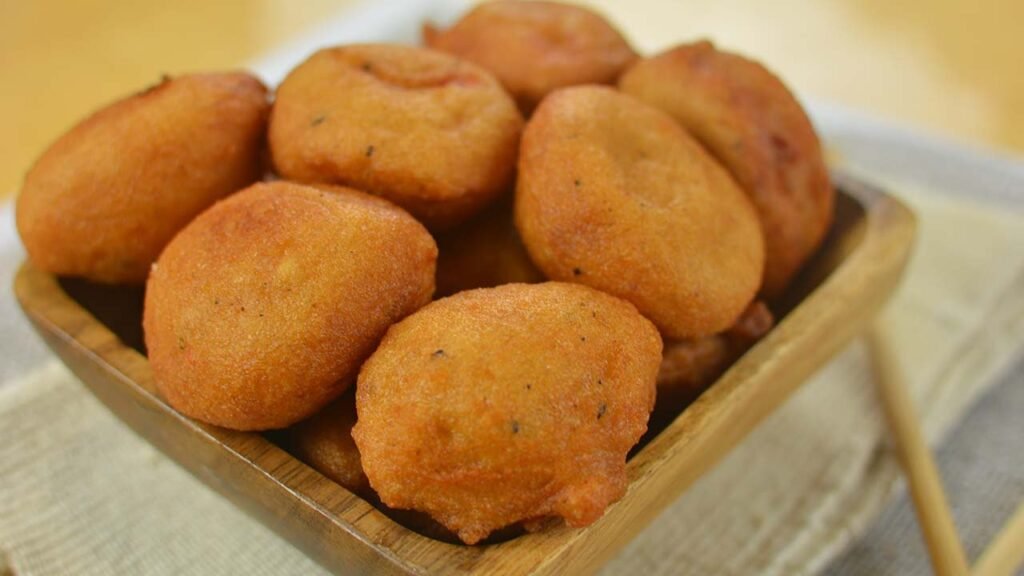
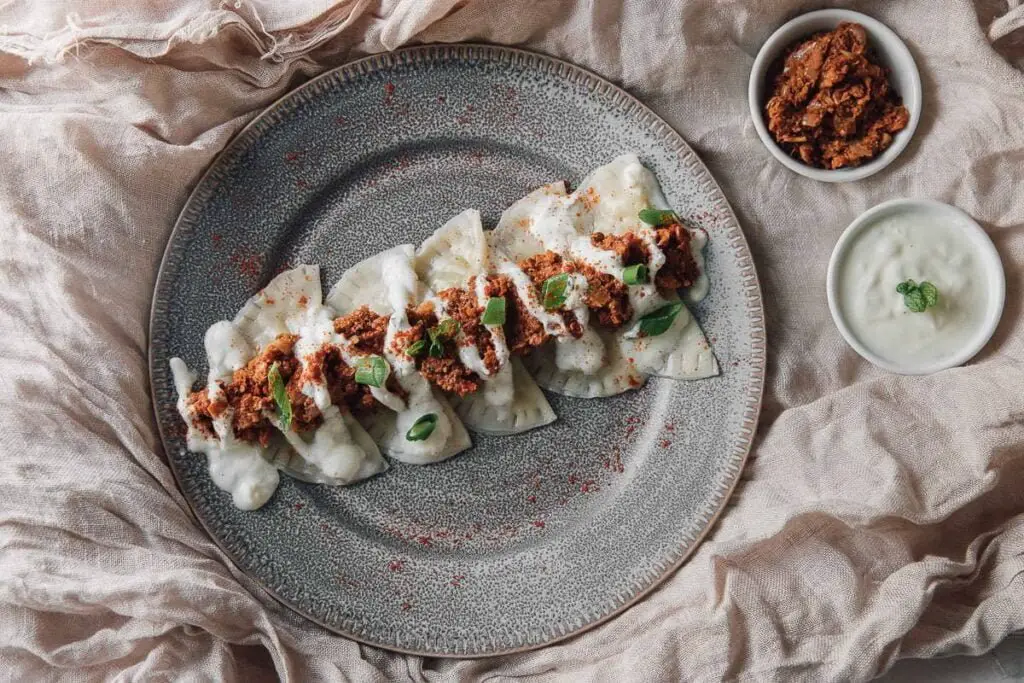

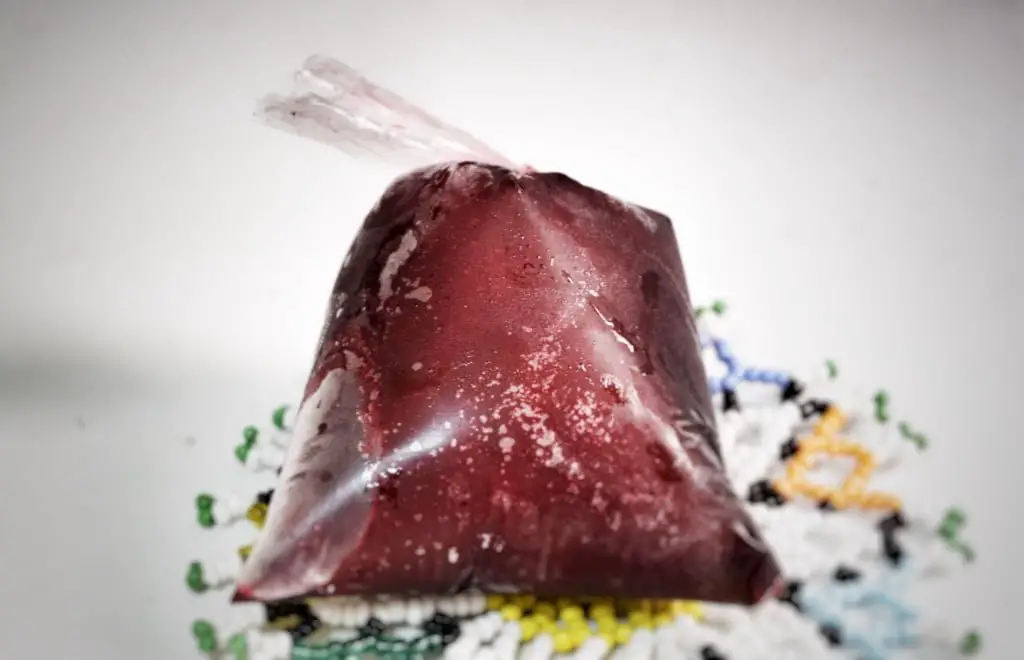
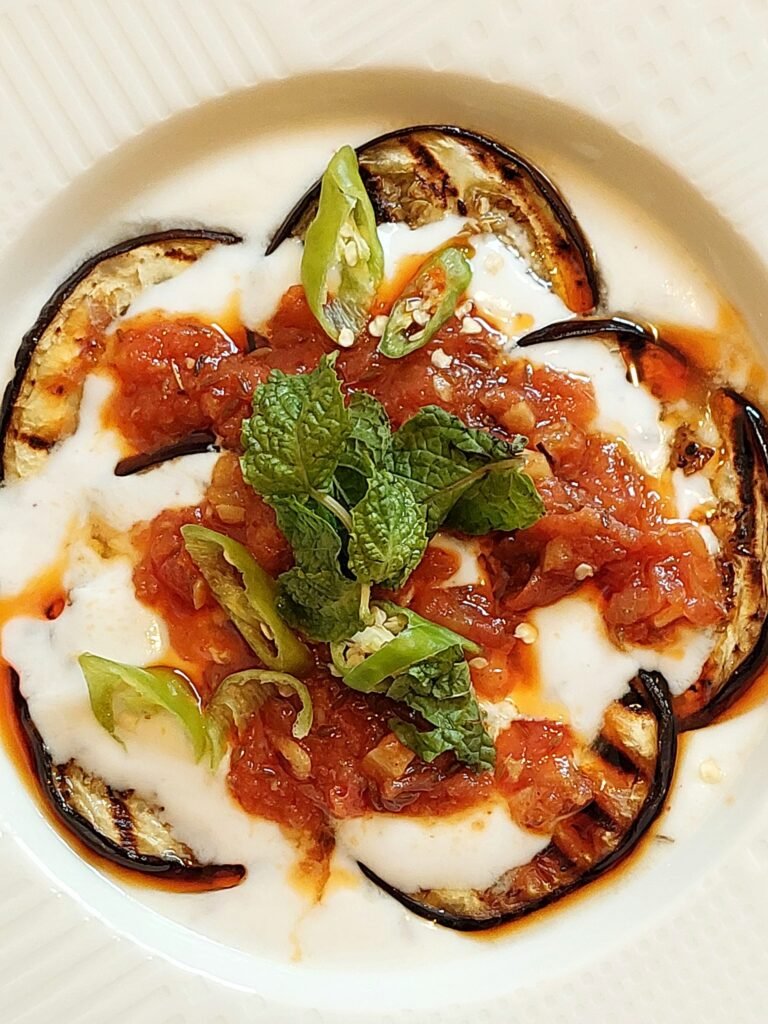
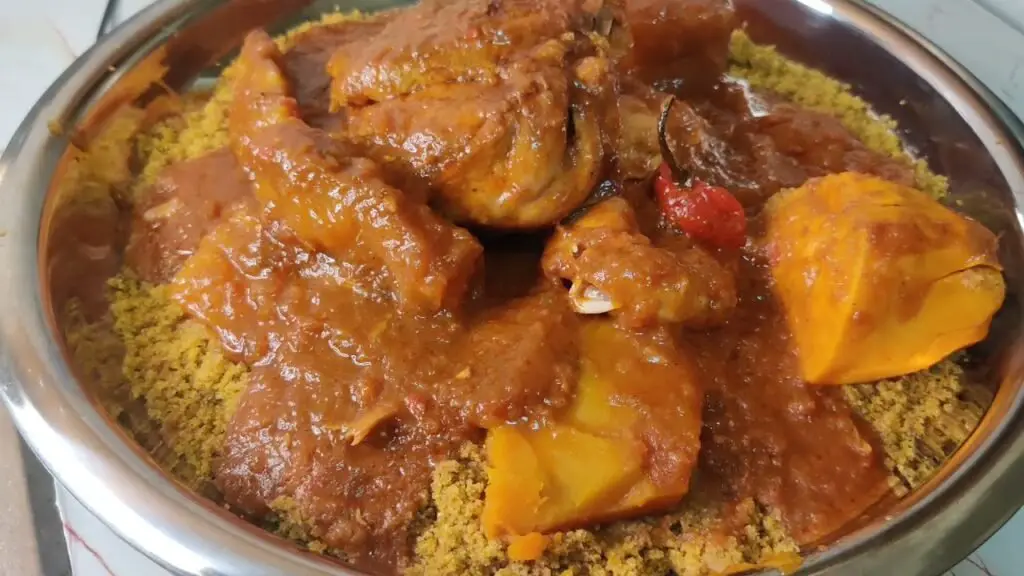


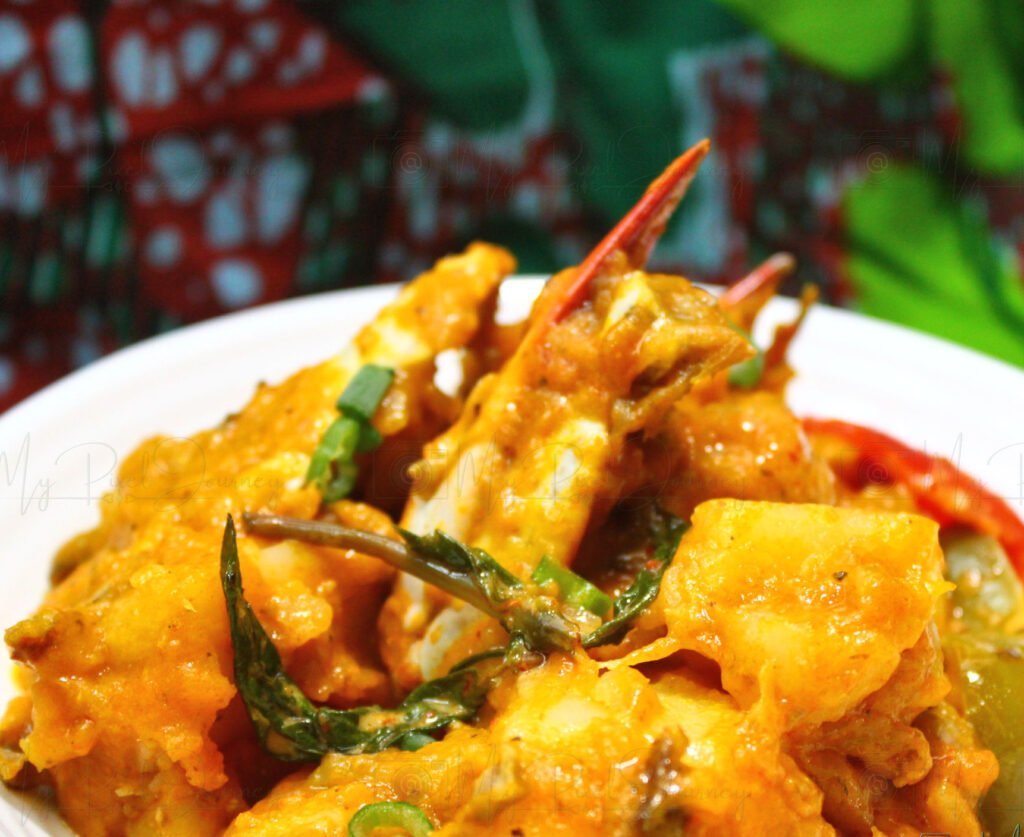
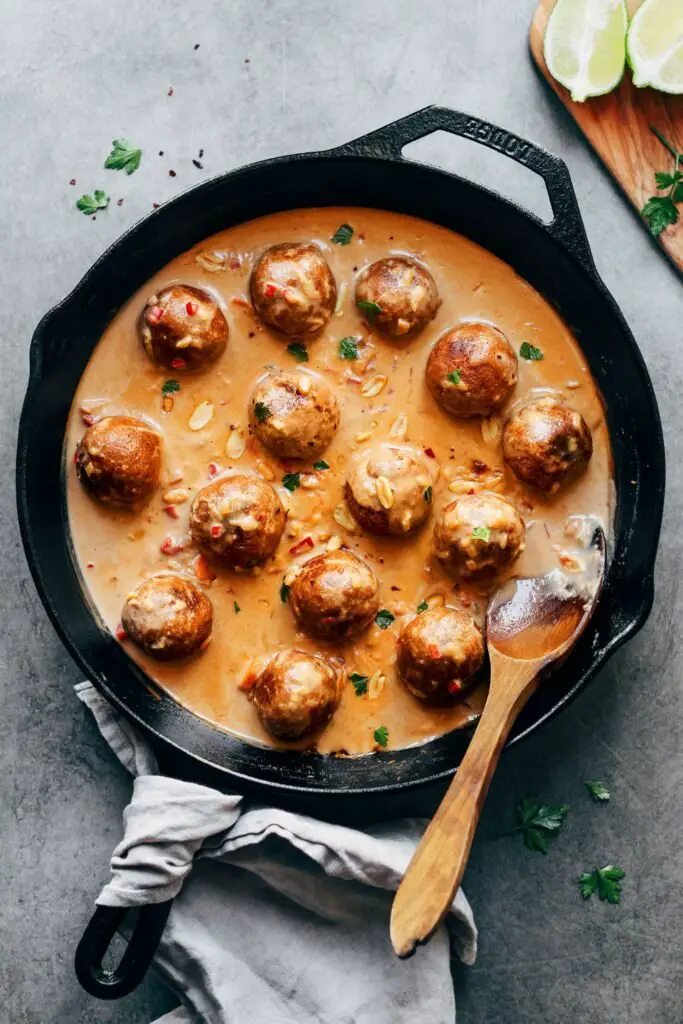
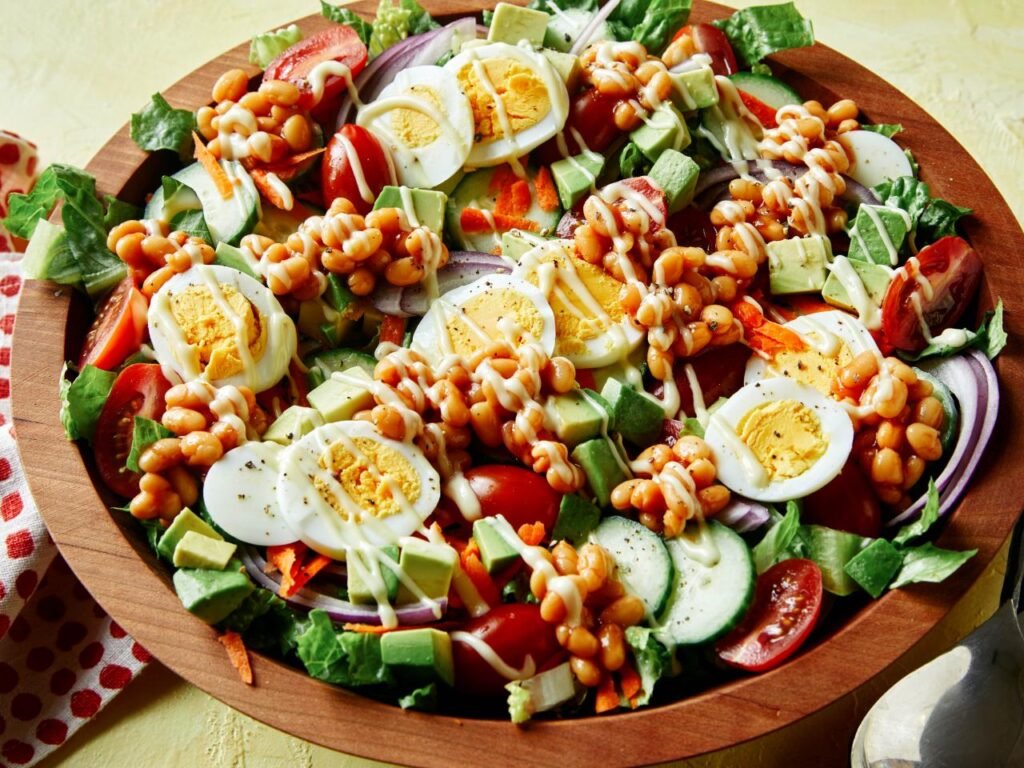

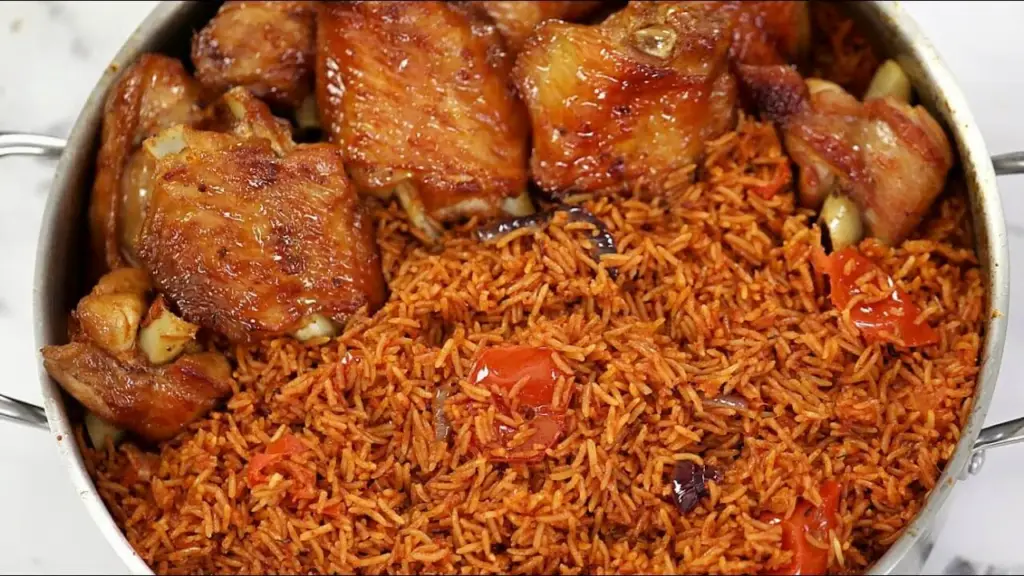
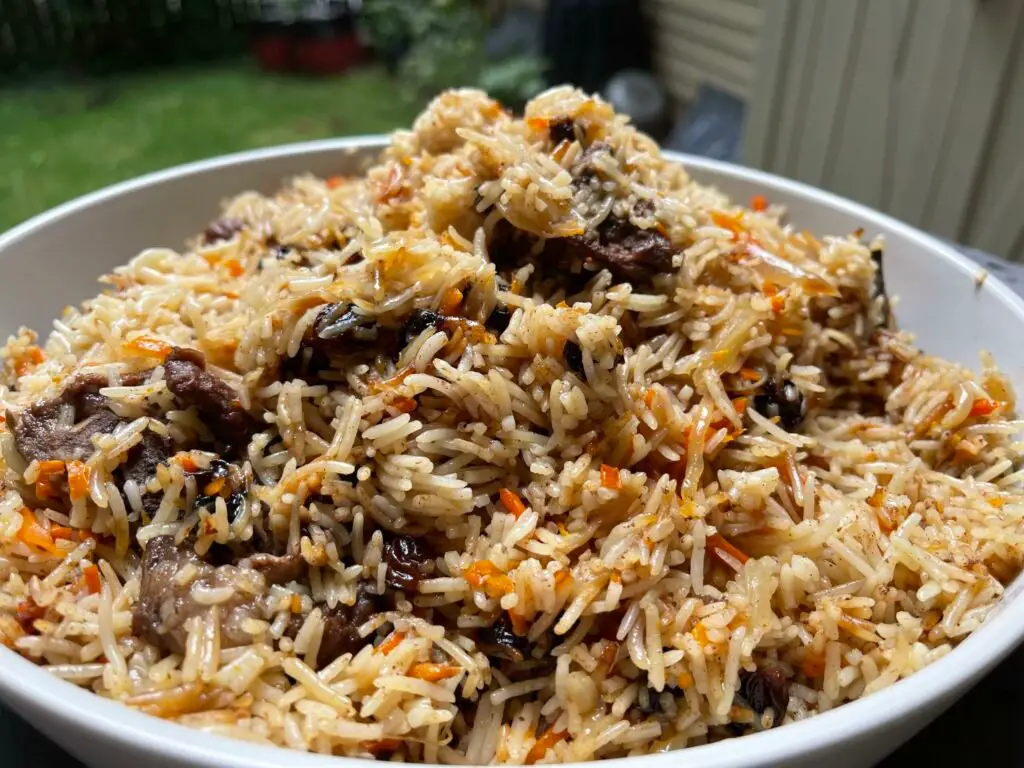
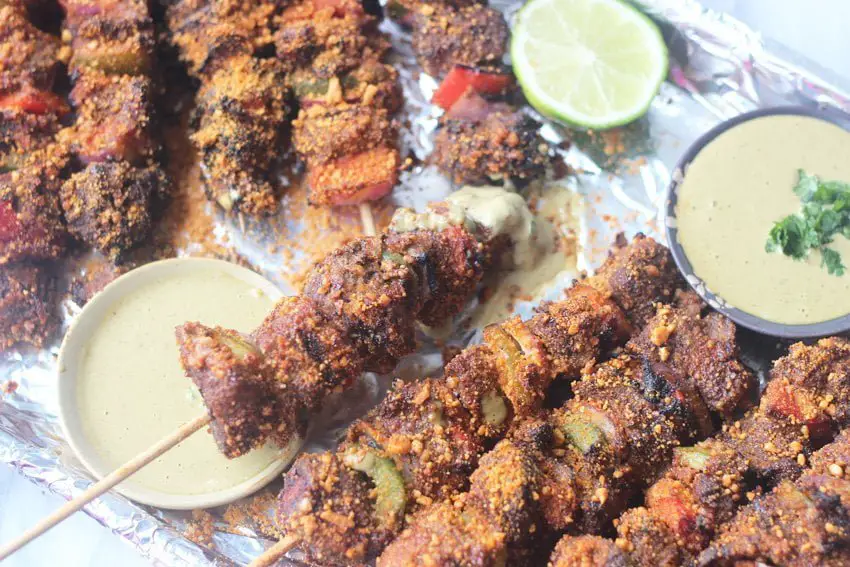
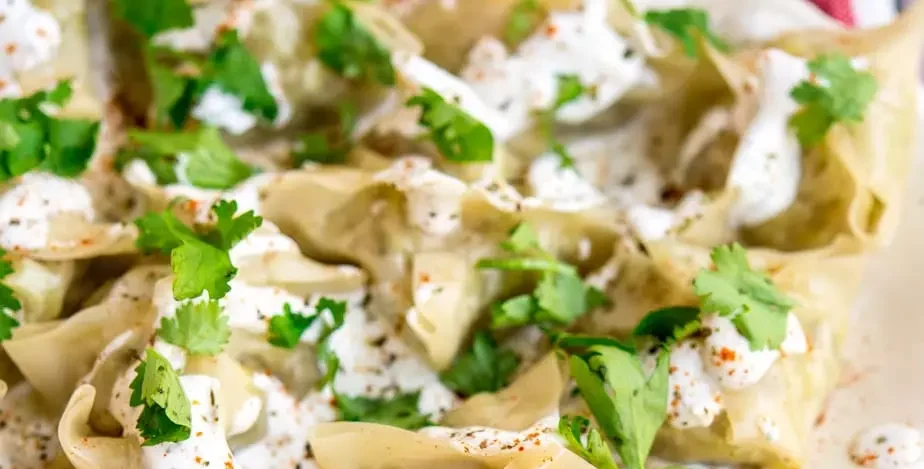
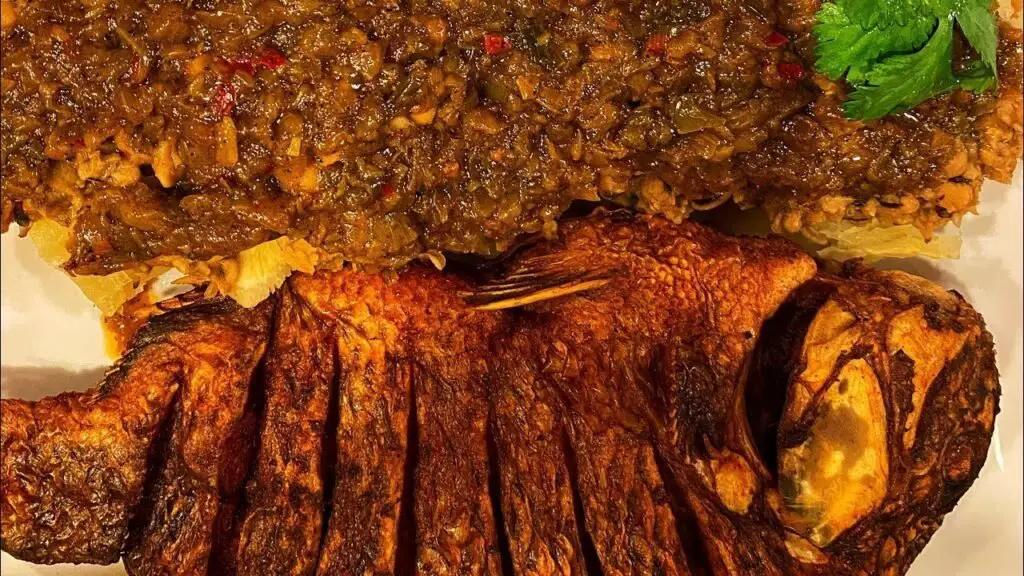

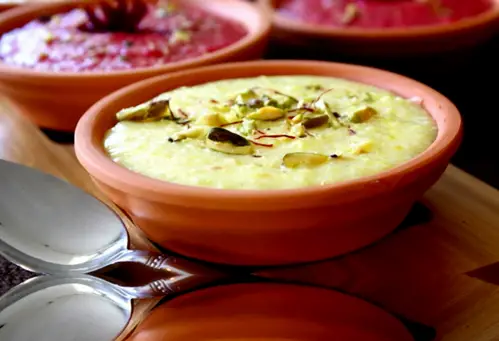
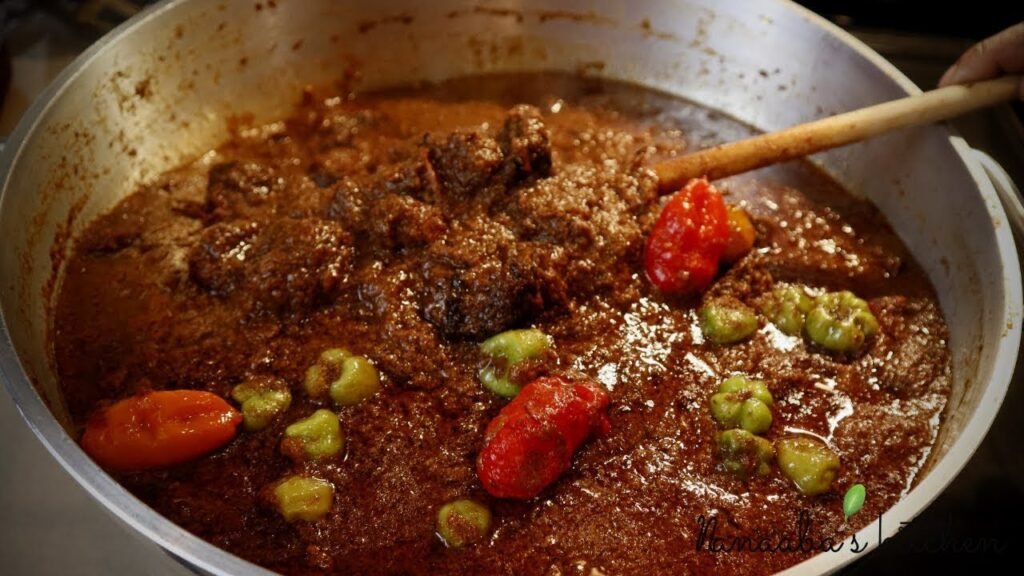
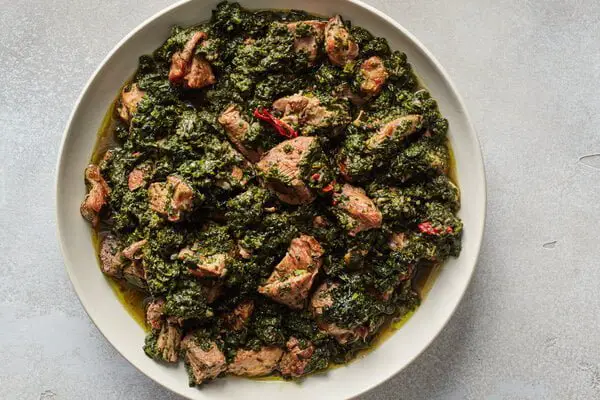
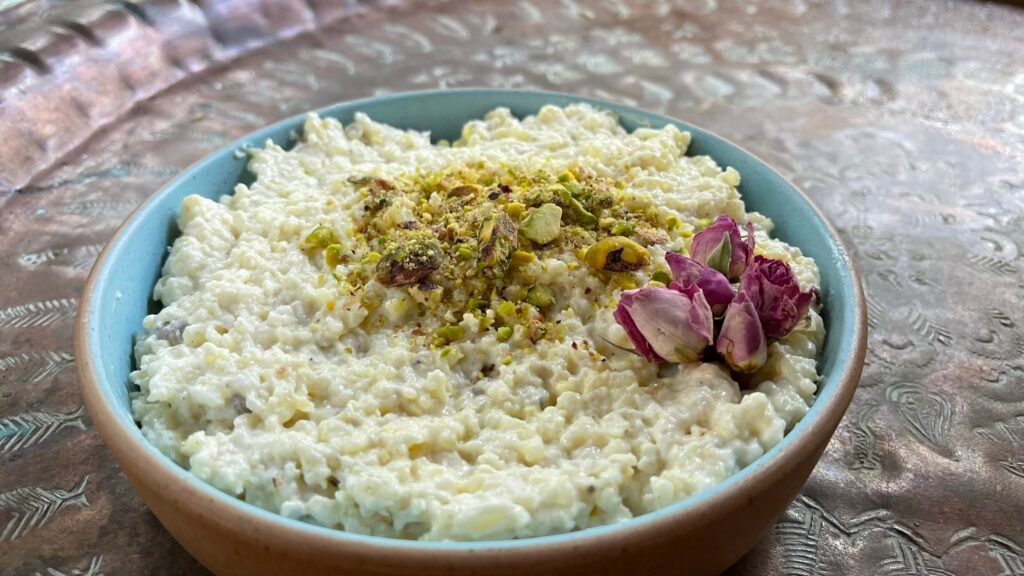


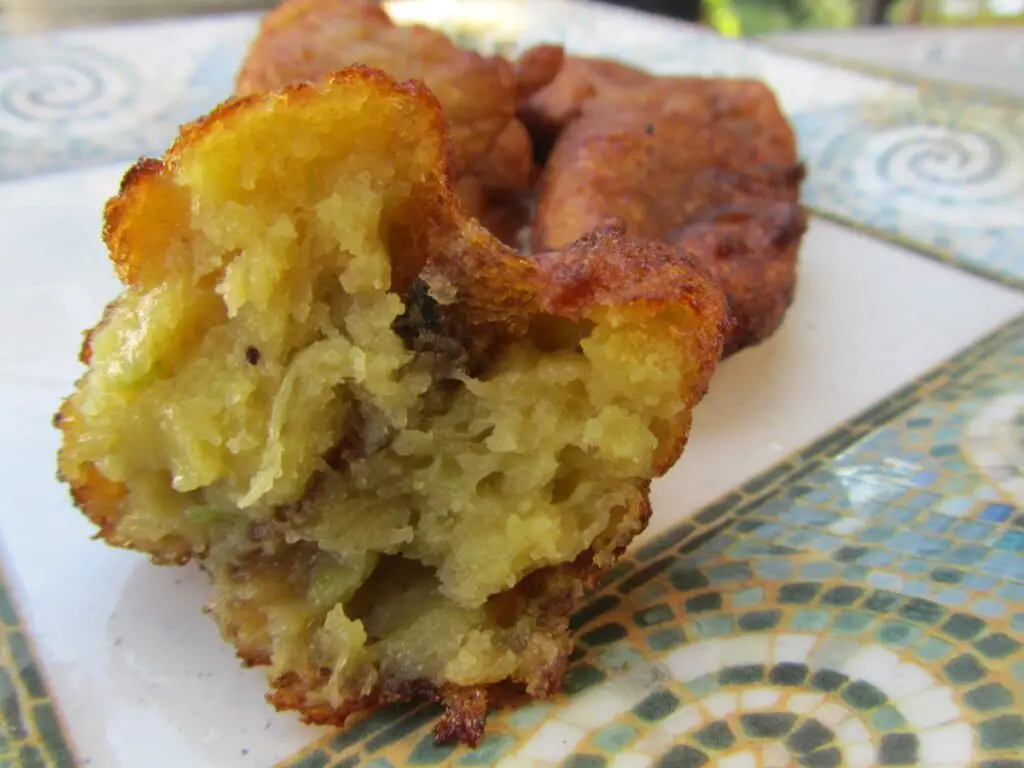
Interesting Facts About the Gambia
Smiling Coast of Africa

The Gambia is often referred to as the “Smiling Coast of Africa” due to the warm and friendly nature of its people. The nickname reflects the country’s reputation for hospitality and the welcoming smiles of its residents.
Enclave within Senegal
The Gambia is a unique geographical entity, surrounded almost entirely by Senegal, with the Atlantic Ocean on its western border. This makes it one of the smallest countries in Africa and creates an interesting geographical configuration.
River Gambia and James Island

The Gambia is named after the Gambia River, which runs through the country. James Island, a historic site along the river, was a key location in the transatlantic slave trade and is now a UNESCO World Heritage Site.
Currency with Wildlife
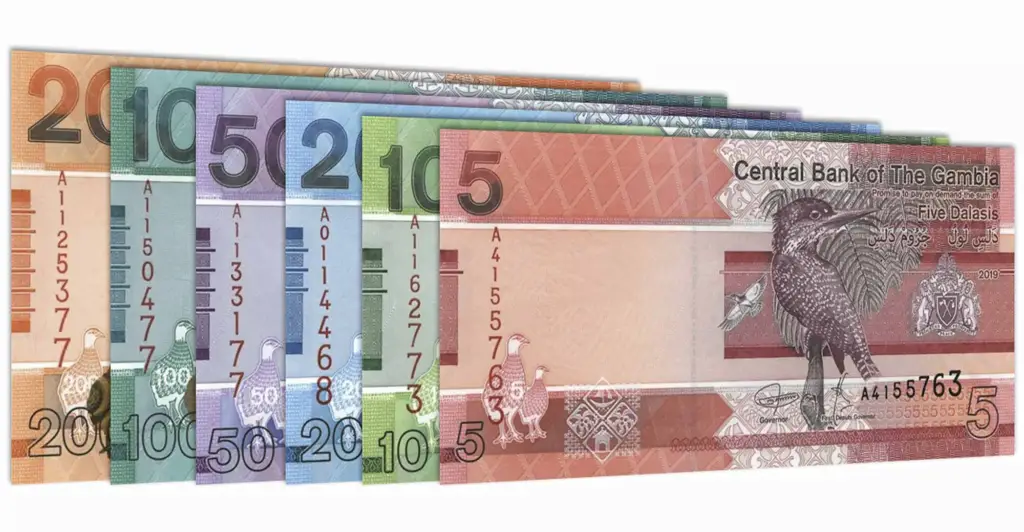
The Gambian currency, the Dalasi, features images of wildlife, including a crocodile. The crocodile is also a sacred symbol in some Gambian cultures, representing strength and protection.
Unique Public Transportation
Public transportation in The Gambia often involves brightly painted, shared minibuses known as “Gelli-Gellis.” These vibrant vehicles are an integral part of the country’s transportation system and are known for their lively decorations.
Arch 22

Arch 22, located in Banjul, is a prominent landmark resembling an arch, built to commemorate the 1994 coup that brought President Yahya Jammeh to power.
The arch is 22 meters tall and has become a distinctive feature of the city skyline.
River Fishing Traditions
Fishing along the Gambia River is a vital part of the country’s economy. The traditional pirogue boats used for fishing often feature colorful paintings, reflecting the vibrant culture of Gambian river communities.
Cultural Diversity
The Gambia is known for its cultural diversity, with various ethnic groups such as the Mandinka, Wolof, Fula, and Jola coexisting harmoniously. This diversity is reflected in traditions, languages, and celebrations throughout the country.
Kankurang Rituals

The Kankurang, a traditional masked figure, is part of a protective ritual in some Gambian cultures. The Kankurang is believed to ward off evil spirits, and its appearances during ceremonies are both fascinating and symbolic.
Historical Link to Alex Haley
The village of Juffureh in The Gambia is renowned for its historical connection to the author Alex Haley. It is believed to be the birthplace of Kunta Kinte, whose life story is depicted in Haley’s novel “Roots.”
The village and its history have attracted visitors interested in African heritage.
The Gambia’s History and the Effect It Has Had on the Cuisine
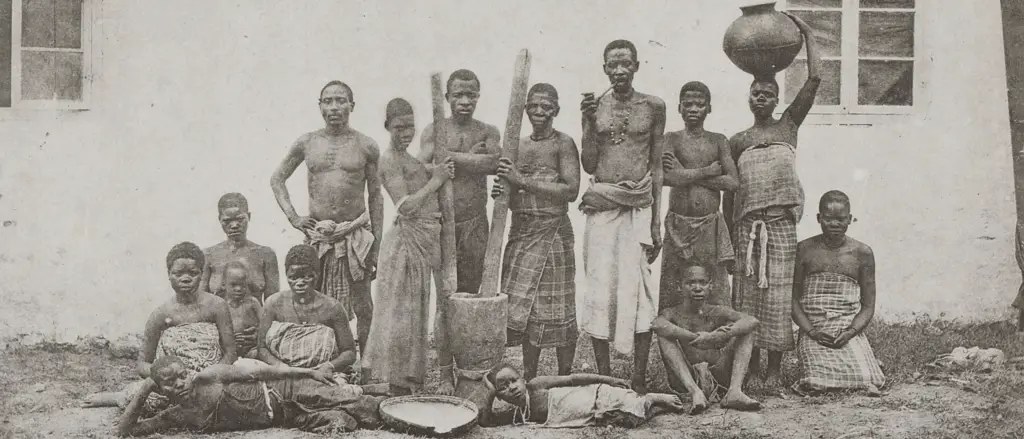
The history of The Gambia has had a profound impact on its cuisine, reflecting the diverse influences of various historical periods.
Pre-Colonial Era: Traditional Subsistence Agriculture
Prior to European colonization, The Gambia’s cuisine was rooted in traditional subsistence agriculture. Indigenous communities engaged in farming practices, cultivating staples such as millet, sorghum, rice, and vegetables.
Fishing along the Gambia River also played a crucial role, contributing to a diet rich in seafood.
European Colonization (15th Century Onwards): Culinary Fusion
The arrival of European colonizers, primarily the Portuguese, significantly influenced Gambian cuisine. The introduction of ingredients such as cassava, maize, and various spices marked a period of culinary fusion.
European trade routes also brought new flavors, including chili peppers and tomatoes, shaping the Gambian palate.
Transatlantic Slave Trade (17th-19th Century): Cultural Exchange

During the transatlantic slave trade, The Gambia served as a significant departure point for slaves. This dark period had a lasting impact on the country’s demographics and, to some extent, its culinary landscape.
The exchange of cultures and ingredients occurred, as enslaved Africans brought their culinary traditions to the Americas, while new foods and cooking methods were introduced to The Gambia.
Colonial Rule (20th Century): Staple Ingredients and Cultural Diversity


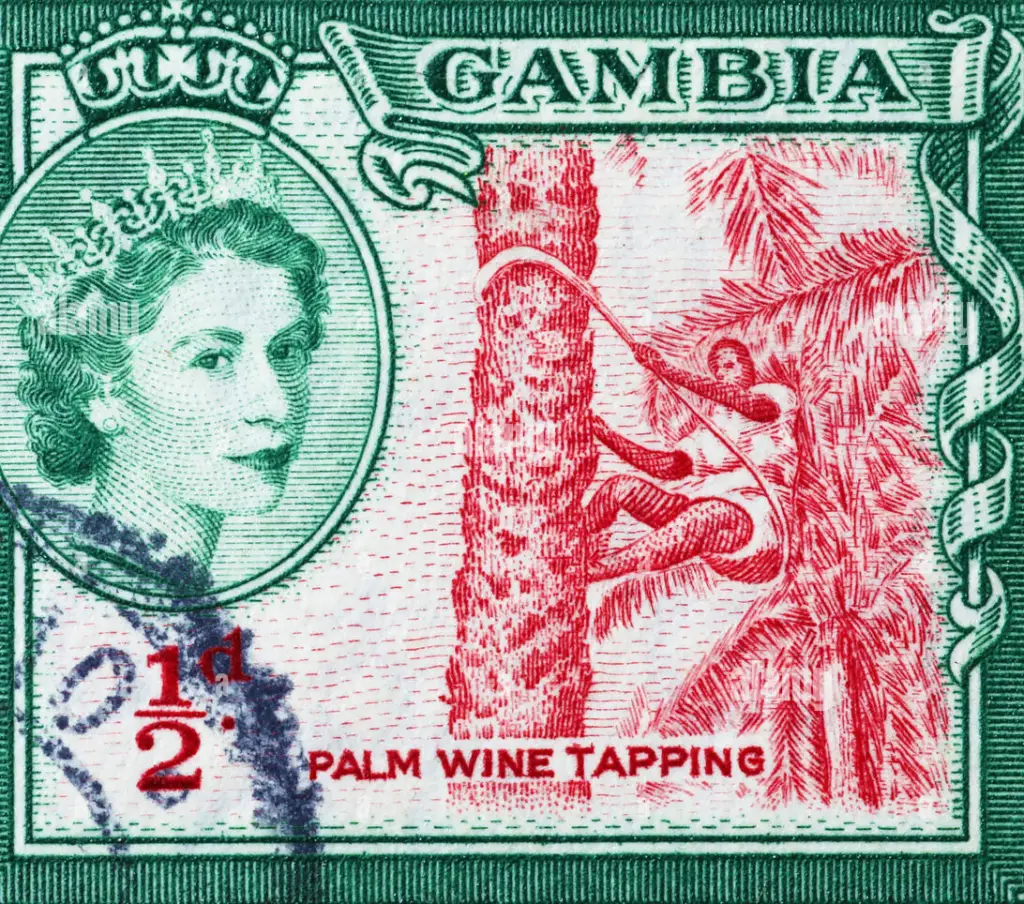

Colonial powers, including the British, significantly influenced Gambian cuisine during the 20th century. The imposition of colonial rule brought about changes in agricultural practices and the cultivation of staple ingredients like rice, which became a dietary cornerstone.
The presence of British colonizers also introduced tea-drinking traditions.
Post-Independence (1965 Onwards): Modernization and Global Influences
The Gambia gained independence from British rule in 1965. Post-independence, the country witnessed modernization and increased globalization, impacting its culinary scene.
The availability of new ingredients, international cuisines, and changing dietary habits became evident, particularly in urban areas.
Contemporary Period: Tourism and Culinary Diversity

In recent years, The Gambia’s cuisine has seen a further evolution, influenced by tourism and a growing appreciation for culinary diversity. The influx of visitors has introduced a demand for a variety of dishes, and local chefs have embraced the opportunity to showcase the richness of Gambian flavors.
The Gambia’s cuisine has been shaped by a dynamic interplay of historical periods, ranging from indigenous practices to European colonization, the transatlantic slave trade, colonial rule, and post-independence changes.
The result is a diverse and flavorful culinary landscape that reflects the country’s complex history and cultural heritage.
What impact has the Climate and Geography had on Gambian Cuisine?

The Climate and Geography of The Gambia significantly influence its cuisine. Let’s delve into how these factors shape the flavors and food practices in this West African nation:
Gambian Geography
River Gambia: The country stretches along the Gambia River, which plays a crucial role in shaping its culinary traditions. The river provides fertile soil for agriculture and supports fishing, contributing to the availability of fresh ingredients.
Coastal Proximity: The Gambia has a 60-kilometer Atlantic Ocean front, which influences its seafood-based dishes. Coastal communities rely on fish, shrimp, and other marine resources.
Landlocked by Senegal: Being surrounded by Senegal, The Gambia shares some culinary similarities with its neighbor. However, it maintains its unique identity through local ingredients and cooking techniques.
Gambian Climate
Rain-fed Agriculture: Much of The Gambia’s agriculture is rain-fed, making it susceptible to climate variations. Changes in precipitation patterns impact crop yields and availability.
Droughts and Floods: The region faces recurrent droughts and floods, affecting food production systems. These shocks lead to fluctuations in food security and contribute to poverty rates.
Saltwater Intrusion: Rising sea levels result in saltwater intrusion, affecting rice farming near the coast. Soil salinity impacts crop growth and flavors, especially in rice dishes.
Food Practices
Groundnuts (Peanuts): The Gambia is known for its groundnut-based dishes. Groundnuts are a staple, used in stews, sauces, and snacks.
Fish and Seafood: Coastal communities rely heavily on fish, shrimp, and oysters. Dishes like domoda (peanut stew with fish or meat) and benachin (one-pot rice dish with fish or chicken) showcase this influence.
Rice: Rice is a staple, often served with various sauces, vegetables, and proteins. The impact of climate change on rice production affects availability and affordability.
Spices and Flavorings: Local spices like beniseed, ginger, and cayenne pepper add depth to Gambian dishes.
Fruits: Mangoes, bananas, and citrus fruits grow abundantly and find their way into desserts and beverages.
References
The Evolution of Gambian Food Recipes: Traditional vs. Modern

Gambian cuisine has come a long way from its traditional roots, but it still holds onto the fundamental elements that make it unique. With globalization and increased access to international ingredients, Gambian cuisine has undergone significant changes, resulting in modern adaptations of traditional recipes.
The Significance of Gambian Culinary Traditions
Gambian culinary traditions evolve over hundreds of years. They reflect the country’s rich cultural heritage and diverse influences from neighboring West African countries. The use of local ingredients, including yams, cassava, plantains, and rice, has been a cornerstone of Gambian cuisine for generations.
Each generation passes traditional Gambian dishes, such as benachin (a one-pot rice dish) and domoda (a peanut stew), to the next. Each family adds their own unique twist. These dishes remain an integral part of Gambian food culture. Locals and visitors alike enjoy them.
Understanding the Essence of Gambian Cuisine

To understand Gambian cuisine is to appreciate the harmony of its flavors and the philosophy behind its preparation. It is a cuisine that prioritizes balance, where the nutty richness of groundnut stews meets the sharp tang of tamarind and the heat of scotch bonnet peppers.
It’s a cuisine that values the communal, where large platters of benechin invite sharing and togetherness. The essence of Gambian cuisine lies in its simplicity and depth, where a handful of quality ingredients come together to create something greater than the sum of its parts.
It is a culinary tradition that speaks to the soul, offering comfort and connection in every bite.
Gambian Culinary Traditions
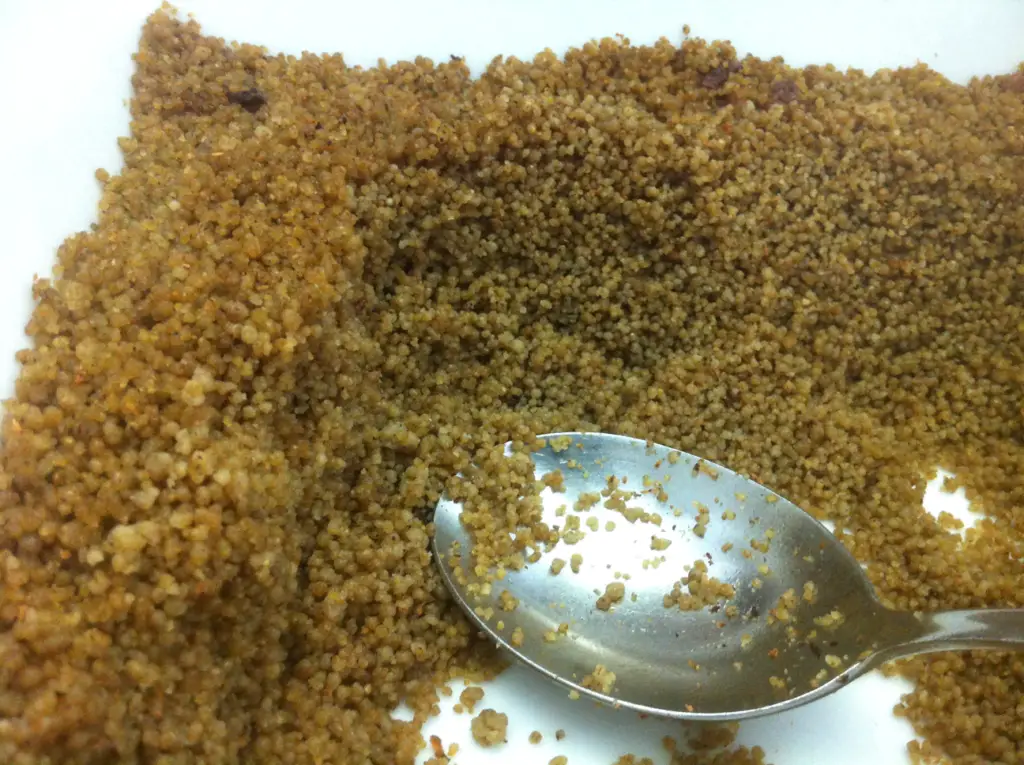
Gambian culinary traditions are a tapestry woven from the threads of community and heritage. Meals are a communal affair, often centered around a shared bowl, symbolizing unity. The traditional ‘chop’ – a term for eating – is a vibrant, interactive experience.
Cooking methods are passed down through generations, with techniques such as slow cooking in clay pots over open fires to infuse dishes with a smoky depth.
The preparation of each dish, from the pounding of millet for couscous to the meticulous marinating of meats for yassa, is done with a rhythm that is almost ceremonial.
These traditions are not just about feeding the body but nourishing the spirit of kinship and continuity.
The Future of Gambian Recipes

As Gambian cuisine evolves, it’s exciting to see how future generations will adapt. With the rise of food bloggers and social media, Gambian cuisine is becoming more accessible than ever before.
This has led to a resurgence of interest in traditional recipes and ingredients, as well as the creation of new, fusion dishes that combine Gambian and other international flavors.
Overall, Gambian culinary traditions remain an integral part of the country’s cultural heritage and identity. While modern adaptations continue to bring new flavors and techniques to the table, it’s important to preserve and celebrate the traditional dishes and cooking techniques that define Gambian cuisine.
Exploring Gambian Ingredients: The Flavors of the Gambia

The flavors of The Gambia are as diverse as its landscapes, ranging from the coastal seafood to the inland orchards. Key ingredients like rice, fish, and groundnuts form the backbone of many dishes, while the use of indigenous fruits and vegetables like baobab and bitter tomato add unique notes.
Spices such as black pepper, cloves, and nutmeg are used with a light hand to enhance, not overpower. The Gambia’s ingredients tell a story of a land blessed by the sun and nurtured by the river, a place where each meal is a celebration of the earth’s bounty.
The careful selection and combination of these ingredients reflect a deep understanding of flavor and a respect for the natural gifts of the land.
Mastering Gambian Cuisine Cooking Techniques
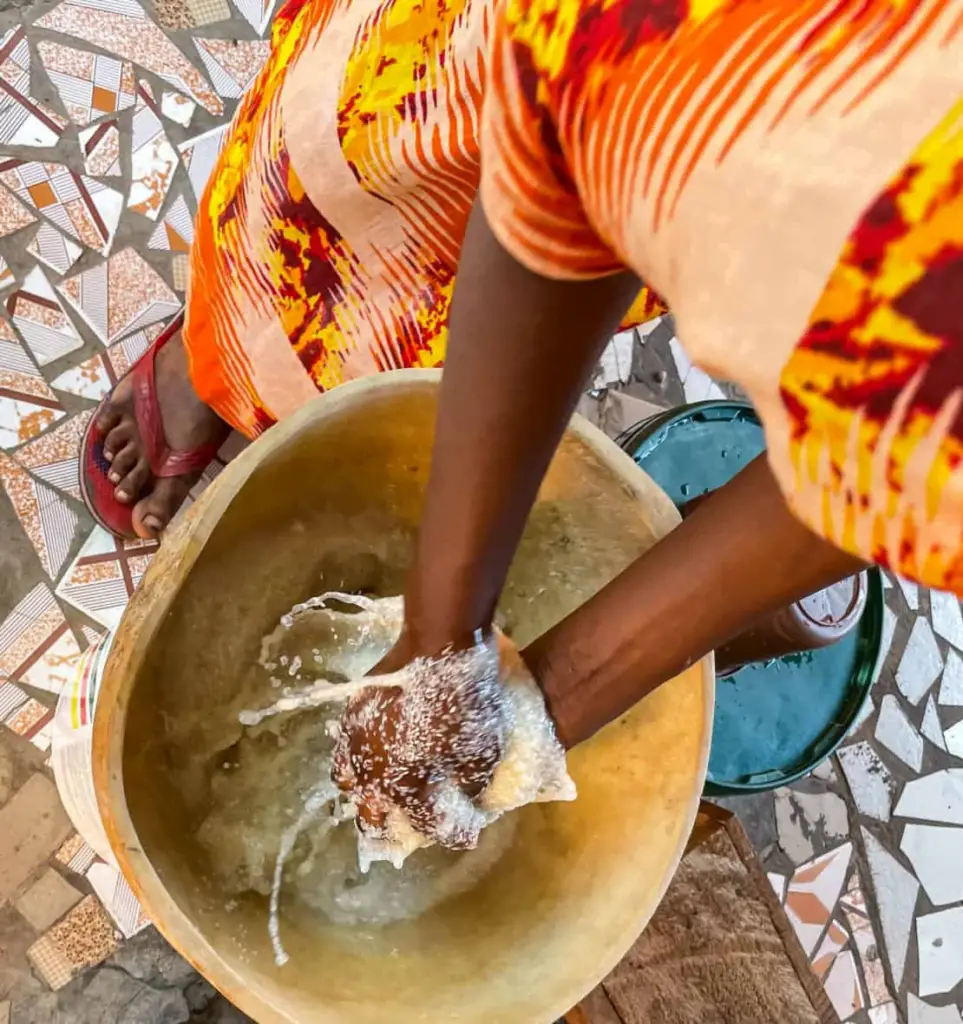
If you’re eager to delve deeper into the world of Gambian cuisine, it’s essential to understand the traditional cooking techniques used in this rich food culture. The techniques employed in Gambian cooking are centered around bringing out the natural flavors of the ingredients, resulting in dishes that are packed with robust and complex flavors.
One of the most prevalent cooking methods in Gambian cuisine is slow-cooking. This technique is used to cook stews, such as domoda (a peanut stew) and benechin (a meat and rice dish), and involves simmering the ingredients over low heat for several hours. The slow-cooking process allows the flavors to meld together beautifully, resulting in a rich and savory stew that is perfect for sopping up with bread or rice.
There are Other Techniques
Another technique that is commonly used in Gambian cooking is grilling. Fish, chicken, and meat are often grilled over an open flame or charcoal, creating a smoky and charred flavor that is unique to this cooking technique. Grilling is particularly popular during festive occasions and is often accompanied by spicy sauces and sides.
The use of specific utensils is also an important aspect of Gambian cooking. For instance, the mortar and pestle are essential tools for grinding spices and herbs, such as ginger, garlic, and chili peppers, which are used to season many dishes. The tawa, a flat pan, is used to cook bread, while the muna (a type of pot) is used to prepare stews and soups.
Lastly, seasoning is key in Gambian cuisine, and herbs and spices are used liberally to add depth and complexity to the dishes. Commonly used spices include ginger, garlic, onion, chili powder, cumin, coriander, and turmeric. Herbs such as parsley, cilantro, and mint are also used to add freshness and flavor.
Traditional Gambian Food

Some of the most popular traditional Gambian dishes that are a must-try include
- Domoda, a hearty peanut stew.ir
- Benechin, a one-pot meal made of rice, meat, and vegetables.
- Mbahal, a spicy fish stew.
These dishes reflect the rich cultural heritage of The Gambia. They highlight its diverse culinary traditions that blend West African and Islamic influences.
Exploring Gambian cuisine and its traditional dishes is an excellent way to delve into the country’s history and culture. Gambian culinary traditions reflect the local ingredients, cultural heritage, and social customs of the region. This makes it a rich and dynamic cuisine. So, get ready to embark on a culinary journey and discover the unique flavors of Traditional Gambian Food.
Gambian cuisine reflects the diverse cultural influences in the country, combining flavors and ingredients from West Africa, the Middle East, and Europe.
Here are some Traditional Gambian Food Recipes
- Benachin (One-Pot Dish): Also known as “Jollof Rice,” Benachin is a popular one-pot rice dish cooked with tomatoes, onions, and various spices. It often includes vegetables, meat, or fish.
- Domoda: This is a groundnut stew made with tomatoes, onions, groundnuts (peanuts), and meat (usually chicken or beef). It is commonly served with rice.
- Yassa: Yassa is a dish made with marinated grilled or roasted chicken or fish. The marinade typically includes onions, garlic, mustard, and lemon juice. It is often served with rice.
- Chereh: Chereh is a traditional soup made with okra, fish, and various spices. It is commonly eaten with rice.
- Benechin: This is another version of the one-pot rice dish, similar to Benachin, but with a distinct recipe in terms of ingredients and preparation.
- Fufu: Fufu is a staple in many West African countries, including Gambia. It is made from starchy vegetables like cassava, yams, or plantains, which are boiled, pounded, and formed into a dough-like consistency. It is often served with soups and stews.
- Tapalapa Bread: This is a popular type of bread in Gambia, often used for sandwiches or enjoyed with stews and soups.
- Superkanja: This is a nutritious leafy green stew made with baobab leaves, groundnuts, and fish or meat. It is usually served with rice.
- Afra: Afra is a popular street food in Gambia, consisting of grilled meat skewers seasoned with spices and served with a spicy pepper sauce.
- Wonjo Juice: This is a refreshing drink made from the hibiscus flower. It is often sweetened and served cold.
It’s important to note that these are just a few examples, and Gambian cuisine is diverse with regional variations. The availability of ingredients and local preferences also influence the specific dishes that are popular in different parts of the country.
Popular Gambian Food Dishes

Domoda
Domoda is a popular Gambian dish, often considered the national dish. It is a hearty stew made with groundnut (peanut) sauce, vegetables, and meat (commonly chicken or beef).
The rich, savory sauce is served over rice or couscous, creating a delicious and filling meal.
Benachin (Jollof Rice)
Benachin, also known as Jollof Rice, is a beloved West African dish and a staple in Gambian cuisine. It consists of rice cooked in a flavorful tomato-based sauce with spices, vegetables, and often accompanied by meat or fish.
Benachin is a festive dish enjoyed during special occasions and celebrations.
Yassa
Yassa is a tangy and aromatic dish that features marinated and grilled chicken or fish, topped with a sauce made from onions, lemons, mustard, and various spices.
The dish is typically served with rice or couscous. Yassa showcases the Gambian preference for bold and zesty flavors.
Superkanja (Moringa Leaf Stew)
Superkanja is a nutritious stew made from moringa leaves, a highly valued ingredient for its health benefits. The stew often includes other leafy greens, fish, and spices.
Superkanja is a flavorful and wholesome dish that highlights the use of locally available, nutrient-rich ingredients.
Afra
Afra is a popular street food and barbecue dish in The Gambia. It consists of marinated and grilled meat skewers, commonly featuring beef, chicken, or lamb.
The meat is seasoned with a blend of spices, giving it a smoky and savory flavor. Afra is often enjoyed as a quick and tasty snack.
These dishes represent the diverse and flavorful nature of Gambian cuisine, blending local ingredients with a variety of spices and cooking techniques. Whether it’s the comforting Domoda, festive Benachin, zesty Yassa, nutritious Superkanja, or the savory Afra, Gambian food offers a delightful culinary journey.
How Healthy is Gambian Food?

The Gambia, a vibrant West African nation, boasts a rich culinary tradition centered around staples like rice, peanuts, fish, and vegetables. But how healthy is this traditional Gambian diet for its people? Let’s delve into the ingredients, explore its strengths and weaknesses, and see if it truly nourishes the nation.
Strengths: A Foundation of Nutrient-Rich Staples
The Gambian diet shines with its reliance on whole grains like rice and millet, providing ample carbohydrates for energy. Peanuts, a key ingredient in many dishes, pack a punch of protein, healthy fats, and fiber.
Fresh vegetables like tomatoes, onions, and leafy greens bring essential vitamins and minerals to the table. Additionally, the use of fish offers crucial omega-3 fatty acids for heart health.
Potential Shortcomings: Diversity and Micronutrient Concerns
While the fundamentals are strong, some areas demand attention. The diet can sometimes lack diversity, with rice being the dominant source of energy. This may limit the intake of key vitamins and minerals.
Iron deficiency, for example, is a concern, particularly among women and children. Additionally, while fish is present, red meat and poultry, rich in iron and zinc, are less commonly consumed.
Modernization’s Mixed Bag
The increasing availability of processed foods like sugary drinks and refined carbohydrates introduces a new challenge. These can displace nutrient-rich traditional options and contribute to rising rates of non-communicable diseases like obesity and diabetes.
References:
Exploring Popular Gambian Recipes in Your Own Kitchen
One of the best ways to experience the unique flavors of Gambian cuisine is by trying out some of the most popular Gambian recipes. These dishes are a reflection of the diverse cultural heritage that has shaped Gambian food culture, with influences from West Africa, North Africa, and beyond.
Here are some must-try Gambian recipes:
Ghana Food – Kabuli Pulao (Afghan national dish)

Exploring the Rich History of Kabuli Pulao
Kabuli Pulao, the national dish of Afghanistan, has a rich history deeply rooted in the country’s culinary traditions. Originating from the capital city, Kabul, this flavorful rice dish has been a staple in Afghan households for generations.
The dish beautifully reflects the country’s diverse cultural influences, with a perfect blend of aromatic spices, tender meat, and fragrant rice. Let’s embark on a culinary journey to recreate this authentic Afghan recipe in the comfort of your home!
Ghana Food – Ingredients for Kabuli Pulao
- 2 cups basmati rice
- 1 pound lamb or beef, cut into bite-sized pieces
- 1 large onion, thinly sliced
- 1/2 cup vegetable oil
- 1 cup julienned carrots
- 1/2 cup raisins
- 1/4 cup slivered almonds
- 1 teaspoon ground cardamom
- 1 teaspoon ground cinnamon
- 1 teaspoon ground cumin
- 1 teaspoon ground coriander
- Salt and pepper to taste
- 4 cups chicken or beef broth
Ghana Food – Recipe for Kabuli Pulao
Preparing the Ingredients
- Rinse the basmati rice under cold water until the water runs clear. Soak the rice in water for 30 minutes, then drain.
- Season the meat with salt, pepper, cardamom, cinnamon, cumin, and coriander. Let it marinate for at least 30 minutes.
Cooking the Pulao
- In a large pot, heat vegetable oil over medium heat. Add sliced onions and cook until golden brown.
- Add the marinated meat to the pot and brown it on all sides.
- Stir in julienned carrots, raisins, and slivered almonds. Cook for an additional 5 minutes.
- Add the soaked and drained rice to the pot, stirring gently to combine with the other ingredients.
- Pour in the chicken or beef broth, bring to a boil, then reduce the heat to low. Cover the pot and simmer for 20-25 minutes, or until the rice is tender and cooked through.
- Once cooked, fluff the rice with a fork and let it sit, covered, for an additional 5 minutes to allow the flavors to meld.
Serving Kabuli Pulao
- Transfer the Kabuli Pulao to a serving platter, arranging the meat, carrots, and almonds on top.
- Garnish with additional almonds and raisins if desired, and serve hot.
Serving Size: 6 people
Cooking Time: Approximately 1 hour
Nutritional Information:
- Calories: 400 per serving
- Protein: 20g per serving
- Fat: 15g per serving
- Carbohydrates: 50g per serving
- Fiber: 3g per serving
Ghana Food – Kebabs

Unraveling the Charm of Ghanaian Kebabs
Ghanaian kebabs are a true delight that reflects the vibrant and diverse culinary landscape of West Africa. Originating from the streets of Accra, the capital city of Ghana, these skewered delights have become a popular snack and street food.
The recipe’s roots are deeply embedded in the rich heritage of Ghana, where bold flavors and aromatic spices come together to create a unique and delicious experience. Let’s bring the flavors of Ghana into our kitchens with these irresistible Ghanaian Kebabs!
Ghana Food – Ingredients for Ghanaian Kebabs
- 1 pound boneless chicken or beef, cut into bite-sized cubes
- 1 large onion, finely chopped
- 2 tablespoons vegetable oil
- 2 tablespoons groundnut paste (peanut butter)
- 1 teaspoon ground cayenne pepper
- 1 teaspoon paprika
- 1 teaspoon garlic powder
- 1 teaspoon ginger powder
- 1 teaspoon dried thyme
- Salt and pepper to taste
- Wooden skewers, soaked in water for 30 minutes
Ghana Food – Recipe for Ghanaian Kebabs
Preparing the Ingredients
- In a bowl, mix together the chopped onion, vegetable oil, groundnut paste, cayenne pepper, paprika, garlic powder, ginger powder, dried thyme, salt, and pepper.
- Add the chicken or beef cubes to the marinade, ensuring each piece is well coated. Allow it to marinate for at least 1 hour, or ideally, overnight in the refrigerator.
Skewering and Grilling
- Preheat the grill or grill pan over medium-high heat.
- Thread the marinated chicken or beef cubes onto the soaked wooden skewers, alternating with pieces of onion.
- Place the skewers on the preheated grill and cook for 10-15 minutes, turning occasionally, until the meat is cooked through and has a nice char on the outside.
Serving Ghanaian Kebabs
- Remove the kebabs from the grill and let them rest for a few minutes.
- Serve the Ghanaian Kebabs hot, garnished with additional chopped onions and a side of your favorite dipping sauce.
Serving Size: 4 people
Cooking Time: Approximately 20 minutes
Nutritional Information:
- Calories: 250 per serving
- Protein: 20g per serving
- Fat: 15g per serving
- Carbohydrates: 8g per serving
- Fiber: 2g per serving
Ghana Food – Mantu

Unveiling the Rich Heritage of Ghanaian Mantu
Mantu, a traditional Ghanaian dish, holds a special place in the hearts of many Ghanaians. Originating from the northern regions of the country, Mantu has been a staple for centuries. This hearty dish is known for its bold flavors and comforting qualities, making it a favorite in Ghanaian households.
With a base of rice and beans, Mantu reflects the diverse agricultural produce of the region. Let’s dive into the heart of Ghanaian cuisine and explore the steps to recreate this authentic Mantu recipe in your own kitchen!
Ingredients for Ghanaian Mantu
- 1 cup long-grain rice
- 1/2 cup black-eyed peas, soaked overnight
- 1 pound chicken or beef, cut into bite-sized pieces
- 1 large onion, finely chopped
- 2 tomatoes, chopped
- 2 tablespoons vegetable oil
- 1 teaspoon ground cayenne pepper
- 1 teaspoon ground ginger
- 1 teaspoon ground garlic
- 1 teaspoon ground cumin
- Salt and pepper to taste
- Fresh parsley or cilantro for garnish
Recipe for Ghanaian Mantu
Preparing the Rice and Beans
- Rinse the rice and black-eyed peas under cold water until the water runs clear.
- In a pot, combine the rice, soaked black-eyed peas, and enough water to cover. Cook until both are tender, approximately 20-25 minutes.
Cooking the Protein
- In a separate pan, heat vegetable oil over medium heat. Add chopped onions and cook until golden brown.
- Add the chicken or beef pieces to the pan, cooking until browned on all sides.
- Stir in chopped tomatoes, cayenne pepper, ground ginger, ground garlic, ground cumin, salt, and pepper. Cook for an additional 10 minutes until the tomatoes are softened.
Assembling Mantu
- Combine the cooked rice and beans with the seasoned protein mixture. Mix well to ensure even distribution of flavors.
- Garnish the Mantu with fresh parsley or cilantro.
Serving Ghanaian Mantu
- Serve Mantu hot, allowing the flavors to meld together. It’s a wholesome and satisfying meal on its own.
Serving Size: 4 people
Cooking Time: Approximately 45 minutes
Nutritional Information:
- Calories: 400 per serving
- Protein: 25g per serving
- Fat: 10g per serving
- Carbohydrates: 55g per serving
- Fiber: 8g per serving
Ghana Food – Ashak

Unraveling the Tradition of Ghanaian Ashak
Ashak, a beloved Ghanaian dish, traces its roots to the rich culinary heritage of the northern regions of the country. This flavorful dish has become a symbol of communal gatherings and celebrations in Ghana.
Ashak is a type of dumpling stuffed with a delectable mixture of seasoned meat, onions, and spices. The dish showcases the influence of Ghana’s diverse cultural landscape, offering a perfect balance of textures and tastes.
Let’s delve into the world of Ashak and learn how to recreate this Ghanaian delight in your own kitchen!
Ghana Food – Ingredients for Ghanaian Ashak
Dumplings:
- 2 cups all-purpose flour
- 1 cup water
- 1/2 teaspoon salt
Filling:
- 1 pound ground beef or lamb
- 1 large onion, finely chopped
- 2 tomatoes, diced
- 2 tablespoons vegetable oil
- 1 teaspoon ground cumin
- 1 teaspoon ground coriander
- Salt and pepper to taste
Yogurt Sauce:
- 1 cup plain yogurt
- 1 clove garlic, minced
- 1 tablespoon fresh mint, chopped
- Salt to taste
Ghana Food – Recipe for Ghanaian Ashak
Making the Dumplings
- In a mixing bowl, combine the all-purpose flour, water, and salt to form a soft dough. Knead the dough for about 5 minutes until it’s smooth. Cover and let it rest for 30 minutes.
Preparing the Filling
- In a skillet, heat vegetable oil over medium heat. Add chopped onions and cook until translucent.
- Add ground beef or lamb to the skillet, breaking it up with a spoon as it cooks.
- Stir in diced tomatoes, ground cumin, ground coriander, salt, and pepper. Cook until the meat is browned and the tomatoes are softened.
Shaping and Cooking Ashak
- Roll out the dough into thin sheets and cut into circles using a round cutter.
- Place a spoonful of the meat filling in the center of each dough circle. Fold the dough in half, sealing the edges to form dumplings.
- Steam the dumplings for 15-20 minutes until they are cooked through.
Making the Yogurt Sauce
- In a bowl, mix together plain yogurt, minced garlic, chopped mint, and salt to taste.
Serving Ghanaian Ashak
- Serve the steamed Ashak dumplings with a side of the yogurt sauce.
Serving Size: 4 people
Cooking Time: Approximately 1 hour
Nutritional Information:
- Calories: 450 per serving
- Protein: 20g per serving
- Fat: 15g per serving
- Carbohydrates: 60g per serving
- Fiber: 4g per serving
Ghana Food – Borani Banjan

Discovering the Culinary Heritage of Ghanaian Borani Banjan
Borani Banjan, a traditional Ghanaian dish, offers a tantalizing blend of flavors that originated from the vibrant kitchens of the country’s northern regions. Known for its aromatic spices and hearty vegetables, this dish reflects the agricultural richness of the area. Borani Banjan is a celebration of eggplants, tomatoes, and a medley of spices that come together to create a mouthwatering experience.
Let’s delve into the history of this delightful Ghanaian dish and learn how to bring its authentic flavors into our homes!
Ghana Food – Ingredients for Ghanaian Borani Banjan
- 2 large eggplants, sliced
- 4 tomatoes, chopped
- 1 large onion, thinly sliced
- 3 cloves garlic, minced
- 2 tablespoons vegetable oil
- 1 teaspoon ground coriander
- 1 teaspoon ground cumin
- 1/2 teaspoon turmeric
- Salt and pepper to taste
- 1 cup plain yogurt
- Fresh cilantro or parsley for garnish
Ghana Food – Recipe for Ghanaian Borani Banjan
Roasting the Eggplants
- Preheat the oven to 400°F (200°C).
- Arrange the eggplant slices on a baking sheet, drizzle with oil, and sprinkle with salt.
- Roast the eggplants in the preheated oven for 20-25 minutes or until they are golden brown and tender.
Preparing the Tomato Sauce
- In a pan, heat vegetable oil over medium heat. Add sliced onions and minced garlic, cooking until they become translucent.
- Add chopped tomatoes, ground coriander, ground cumin, turmeric, salt, and pepper. Simmer for 15-20 minutes until the tomatoes are soft and the sauce thickens.
Assembling Borani Banjan
- Arrange the roasted eggplant slices on a serving platter.
- Spoon the tomato sauce over the eggplants, ensuring an even distribution.
- Drizzle plain yogurt over the top and garnish with fresh cilantro or parsley.
Serving Ghanaian Borani Banjan
- Serve Borani Banjan warm, allowing the flavors to meld together.
Serving Size: 4 people
Cooking Time: Approximately 45 minutes
Nutritional Information:
- Calories: 150 per serving
- Protein: 5g per serving
- Fat: 8g per serving
- Carbohydrates: 18g per serving
- Fiber: 6g per serving
Ghana Food – Qorma (meat stew)

Unraveling the Heritage of Ghanaian Qorma
Qorma, a hearty and aromatic meat stew, holds its roots in the rich culinary traditions of Ghana. Originating from the northern regions, this dish reflects the essence of communal gatherings and the celebration of flavors.
Qorma showcases the diverse spices and ingredients that make Ghanaian cuisine unique. Often prepared for special occasions and family gatherings, this meat stew is a true representation of the warm and inviting nature of Ghanaian hospitality.
Ghana Food – Ingredients for Ghanaian Qorma
- 1.5 pounds beef or lamb, cut into bite-sized pieces
- 2 large onions, finely chopped
- 3 tomatoes, diced
- 3 tablespoons vegetable oil
- 1 teaspoon ground coriander
- 1 teaspoon ground cumin
- 1 teaspoon ground turmeric
- 1 teaspoon ground paprika
- 1 teaspoon ground cinnamon
- 1 teaspoon ground cardamom
- Salt and pepper to taste
- 1 cup plain yogurt
- Fresh cilantro or parsley for garnish
Ghana Food – Recipe for Ghanaian Qorma
Preparing the Meat
- In a large pot, heat vegetable oil over medium heat. Add chopped onions and cook until golden brown.
- Add the meat pieces to the pot, browning them on all sides.
- Stir in diced tomatoes, ground coriander, ground cumin, ground turmeric, ground paprika, ground cinnamon, ground cardamom, salt, and pepper. Cook until the tomatoes are softened.
Simmering the Stew
- Pour in enough water to cover the meat, bring to a boil, then reduce the heat to low. Cover and simmer for 1.5 to 2 hours, or until the meat is tender and the flavors have melded together.
Adding Yogurt and Finishing
- Stir in plain yogurt, allowing it to blend into the stew. Simmer for an additional 15-20 minutes.
- Adjust the seasoning to taste and let the Qorma sit for a few minutes before serving.
Serving Ghanaian Qorma
- Garnish the Qorma with fresh cilantro or parsley and serve hot over rice or with flatbread.
Serving Size: 6 people
Cooking Time: Approximately 2.5 hours
Nutritional Information:
- Calories: 300 per serving
- Protein: 25g per serving
- Fat: 15g per serving
- Carbohydrates: 10g per serving
- Fiber: 2g per serving
Ghana Food – Sabzi (spinach and herb stew)

Exploring the Culinary Tapestry of Ghanaian Sabzi
Sabzi, a delightful spinach and herb stew, has deep roots in the culinary heritage of Ghana. Originating from the central regions, this flavorful dish captures the essence of Ghanaian cuisine. Packed with vibrant greens and a medley of aromatic herbs, Sabzi is a celebration of fresh and wholesome ingredients.
The stew has been a cherished part of Ghanaian households, offering a nourishing and comforting experience. Let’s embark on a journey to recreate the authentic flavors of Sabzi in your own kitchen!
Ghana Food – Ingredients for Ghanaian Sabzi
- 2 bunches of fresh spinach, washed and chopped
- 1 cup chopped kale
- 1 cup chopped collard greens
- 1 cup chopped fresh parsley
- 1 cup chopped fresh cilantro
- 1 large onion, finely chopped
- 3 tomatoes, diced
- 3 tablespoons vegetable oil
- 1 teaspoon ground coriander
- 1 teaspoon ground cumin
- 1 teaspoon ground turmeric
- 1 teaspoon ground paprika
- Salt and pepper to taste
- 1 cup vegetable broth
- 1 cup coconut milk
Ghana Food – Recipe for Ghanaian Sabzi
Preparing the Greens
- In a large pot, heat vegetable oil over medium heat. Add chopped onions and cook until softened.
- Add chopped tomatoes to the pot, cooking until they break down and create a rich base.
Cooking the Greens
- Stir in chopped spinach, kale, collard greens, parsley, and cilantro. Cook until the greens are wilted and tender.
- Add ground coriander, ground cumin, ground turmeric, ground paprika, salt, and pepper. Mix well to incorporate the spices.
Simmering the Stew
- Pour in vegetable broth and coconut milk, bringing the mixture to a gentle simmer. Allow it to simmer for 20-25 minutes, letting the flavors meld together.
Adjusting Seasoning and Serving
- Adjust the seasoning to taste and let the Sabzi sit for a few minutes before serving.
- Serve the Sabzi hot over rice or with a side of flatbread.
Serving Size: 4 people
Cooking Time: Approximately 30 minutes
Nutritional Information:
- Calories: 250 per serving
- Protein: 8g per serving
- Fat: 18g per serving
- Carbohydrates: 20g per serving
- Fiber: 6g per serving
Ghana Food – Firni

Discovering the Delightful World of Ghanaian Firni
Firni, a luscious and creamy rice pudding, has its origins deeply rooted in the culinary traditions of Ghana. This beloved dessert has been a sweet finale to many Ghanaian meals, offering a comforting and indulgent experience.
Originating from the central regions of the country, Firni reflects the influence of Ghana’s diverse ingredients and culinary techniques. Let’s dive into the history of this delectable treat and learn how to recreate its velvety goodness in your own kitchen!
Ghana Food – Ingredients for Ghanaian Firni
- 1/2 cup basmati rice
- 4 cups whole milk
- 1/2 cup sugar
- 1/4 cup cornstarch
- 1/2 teaspoon ground cardamom
- 1/4 cup chopped almonds or pistachios
- 1 teaspoon rose water (optional)
- Ground cinnamon for garnish
Ghana Food – Recipe for Ghanaian Firni
Preparing the Rice Mixture
- Rinse the basmati rice under cold water until the water runs clear.
- In a blender, combine the rice with 1 cup of milk and blend until smooth.
Cooking the Firni Base
- In a saucepan, heat the remaining 3 cups of milk over medium heat until it starts to simmer.
- Add the rice mixture to the simmering milk, stirring continuously to avoid lumps.
- Once the mixture thickens, add sugar and continue stirring.
Adding Aromatics and Nuts
- Sprinkle in ground cardamom and stir well. If desired, add rose water for a fragrant touch.
- Mix in chopped almonds or pistachios, reserving some for garnish.
Finalizing and Chilling
- In a small bowl, dissolve cornstarch in a little cold milk and add it to the Firni. Continue cooking until the mixture thickens to a pudding-like consistency.
- Remove from heat and let the Firni cool slightly before transferring it to individual serving dishes.
- Chill the Firni in the refrigerator for at least 2 hours or until set.
Serving Ghanaian Firni
- Garnish each serving with a sprinkle of ground cinnamon and reserved chopped nuts.
- Serve chilled and enjoy the creamy sweetness of this Ghanaian delicacy!
Serving Size: 6 people
Cooking Time: Approximately 30 minutes
Chilling Time: 2 hours
Nutritional Information:
- Calories: 200 per serving
- Protein: 6g per serving
- Fat: 8g per serving
- Carbohydrates: 30g per serving
- Fiber: 1g per serving
Ghana Food – Sheer Birinj

Unraveling the Culinary Heritage of Ghanaian Sheer Birinj
Sheer Birinj, a delightful and fragrant rice pudding, takes us on a journey through the rich culinary tapestry of Ghana. Originating from the northern regions, this sweet and creamy dessert holds a special place in Ghanaian celebrations and gatherings.
The name “Sheer Birinj” translates to “milk rice,” showcasing the key ingredients that contribute to its velvety texture. Steeped in tradition, this dish reflects the warmth and hospitality of Ghanaian culture. Let’s dive into the history of Sheer Birinj and learn how to bring its comforting sweetness into our homes!
Ghana Food – Ingredients for Ghanaian Sheer Birinj
- 1 cup basmati rice
- 4 cups whole milk
- 1/2 cup sugar
- 1/4 cup ghee (clarified butter)
- 1/4 cup raisins
- 1/4 cup slivered almonds
- 1/2 teaspoon ground cardamom
- A pinch of saffron strands (optional)
- Ground cinnamon for garnish
Ghana Food – Recipe for Ghanaian Sheer Birinj
Cooking the Rice
- Rinse the basmati rice under cold water until the water runs clear.
- In a large pot, bring 4 cups of water to a boil. Add the rinsed rice and cook until it’s 70-80% done. Drain and set aside.
Preparing the Milk Mixture
- In a separate pot, heat the whole milk over medium heat until it begins to simmer.
- Add the partially cooked rice to the simmering milk, stirring continuously to prevent sticking.
Sweetening and Flavoring
- Mix in sugar, ghee, raisins, slivered almonds, ground cardamom, and saffron strands if using. Stir well to combine.
- Continue to simmer the mixture, stirring occasionally, until the rice is fully cooked, and the Sheer Birinj reaches a thick and creamy consistency.
Final Touch and Serving
- Once the Sheer Birinj is ready, remove it from heat and let it cool slightly.
- Transfer the Sheer Birinj to serving bowls, garnish with a sprinkle of ground cinnamon, and serve warm.
Serving Size: 6 people
Cooking Time: Approximately 45 minutes
Nutritional Information:
- Calories: 300 per serving
- Protein: 8g per serving
- Fat: 10g per serving
- Carbohydrates: 45g per serving
- Fiber: 2g per serving
Ghana Food – Sweet and Nutty Sheer Yakh

Unveiling the Exquisite Flavor of Ghanaian Sweet and Nutty Sheer Yakh
Sweet and Nutty Sheer Yakh, a delightful dessert hailing from the northern regions of Ghana, is a symphony of rich flavors and textures. This traditional treat has been cherished for its sweet, creamy, and nutty profile. With roots in Ghanaian culinary history, Sheer Yakh has become a beloved dish, often served during festive occasions and celebrations.
The dish’s name, “Sheer Yakh,” translates to “sweet ice,” showcasing its refreshing and indulgent qualities. Join me on a culinary journey as we recreate the magic of Sweet and Nutty Sheer Yakh in our own kitchens!
Ghana Food – Ingredients for Ghanaian Sweet and Nutty Sheer Yakh
- 1 cup basmati rice
- 4 cups whole milk
- 1 cup condensed milk
- 1/2 cup sugar
- 1/4 cup ghee (clarified butter)
- 1/2 cup chopped mixed nuts (almonds, pistachios, and cashews)
- 1/4 cup raisins
- 1/2 teaspoon ground cardamom
- 1/4 teaspoon saffron strands (optional)
- Ice cubes for serving
Ghana Food – Recipe for Ghanaian Sweet and Nutty Sheer Yakh
Cooking the Rice and Preparing the Milk Base
- Rinse basmati rice under cold water until it runs clear.
- In a pot, bring 4 cups of water to a boil. Add the rinsed rice and cook until it’s 70-80% done. Drain and set aside.
- In a separate pot, heat whole milk over medium heat until it starts to simmer.
Sweetening the Mixture
- Add the partially cooked rice to the simmering milk, stirring continuously to prevent sticking.
- Mix in condensed milk, sugar, ghee, chopped mixed nuts, raisins, ground cardamom, and saffron strands if using. Stir well.
Simmering to Perfection
- Continue to simmer the mixture, stirring occasionally, until the rice is fully cooked, and Sheer Yakh attains a thick and creamy consistency.
Cooling and Serving
- Once done, let the Sheer Yakh cool to room temperature. Refrigerate for a few hours until it’s well-chilled.
- Serve Sweet and Nutty Sheer Yakh over ice cubes for a refreshing touch.
Serving Size: 6 people
Cooking Time: Approximately 45 minutes
Chilling Time: 2 hours
Nutritional Information:
- Calories: 350 per serving
- Protein: 8g per serving
- Fat: 15g per serving
- Carbohydrates: 50g per serving
- Fiber: 1g per serving
Ghana Food – Akara (Bean Fritters)

Embarking on a Flavorful Journey with Ghanaian Akara
Akara, a beloved Ghanaian street food, has its roots in the rich culinary traditions of West Africa. Originating from the Hausa people, this delectable dish has become a staple across the region, known for its crispy exterior and soft, savory interior.
Akara is a favorite breakfast or snack, often enjoyed with a side of spicy pepper sauce. As we delve into the heart of Ghanaian cuisine, let’s explore the art of making these irresistible Bean Fritters that carry with them the warmth and flavors of West Africa.
Ghana Food – Ingredients for Ghanaian Akara
- 2 cups black-eyed peas, soaked overnight
- 1 medium onion, roughly chopped
- 2 cloves garlic
- 1 teaspoon ground pepper (adjust to taste)
- 1 teaspoon ground ginger
- Salt to taste
- Vegetable oil for frying
Ghana Food – Recipe for Ghanaian Akara
Preparing the Black-Eyed Peas
- Drain the soaked black-eyed peas and rinse them thoroughly under cold water.
- In a blender or food processor, combine the black-eyed peas, chopped onion, garlic, ground pepper, ground ginger, and salt. Blend until you achieve a smooth, thick batter.
Frying the Akara
- In a deep pan, heat vegetable oil over medium heat until it reaches 350°F (180°C).
- Carefully drop spoonfulls of the batter into the hot oil, creating small fritters. Fry until they turn golden brown, ensuring even cooking by flipping them as needed.
Draining and Serving
- Once the Akara fritters are crisp and golden, use a slotted spoon to remove them from the oil, allowing any excess oil to drain.
- Place the Akara on a plate lined with paper towels to absorb any remaining oil.
Serving Ghanaian Akara
- Serve the Akara hot, either on its own or with a side of spicy pepper sauce for an extra kick.
Serving Size: 4 people
Cooking Time: Approximately 30 minutes
Nutritional Information:
- Calories: 150 per serving
- Protein: 8g per serving
- Fat: 5g per serving
- Carbohydrates: 20g per serving
- Fiber: 5g per serving
Ghana Food – Ebbeh (Fish and Vegetable Soup)

Exploring the Authenticity of Ghanaian Ebbeh
Ebbeh, a hearty fish and vegetable soup, emerges from the culinary heart of Ghana, specifically from the coastal regions where fresh seafood is abundant. This traditional dish reflects the influence of both Ghanaian and West African culinary traditions, combining local ingredients to create a flavorful and nutritious soup.
Ebbeh is not only a delicious and comforting dish but also a celebration of the diverse flavors that characterize Ghanaian cuisine. Let’s dive into the history of Ebbeh and embark on a culinary journey to recreate this delectable fish and vegetable soup in your own kitchen.
Ghana Food – Ingredients for Ghanaian Ebbeh
- 1 pound fresh fish fillets (tilapia or catfish)
- 1 cup okra, sliced
- 1 cup eggplant, diced
- 1 cup pumpkin, diced
- 1 medium onion, chopped
- 2 tomatoes, diced
- 2 tablespoons groundnut oil (peanut oil)
- 2 tablespoons tomato paste
- 1 teaspoon ground pepper
- 1 teaspoon ground ginger
- Salt to taste
- 4 cups fish or vegetable broth
- Fresh cilantro or parsley for garnish
Ghana Food – Recipe for Ghanaian Ebbeh
Preparing the Fish
- Clean and wash the fish fillets thoroughly. Cut them into bite-sized pieces.
Sautéing the Vegetables
- In a large pot, heat groundnut oil over medium heat. Add chopped onions and sauté until golden brown.
- Add diced tomatoes, ground pepper, and ground ginger. Cook until the tomatoes are softened.
Building the Soup Base
- Stir in tomato paste and cook for an additional 2-3 minutes.
- Add fish or vegetable broth to the pot, bringing it to a gentle boil.
Cooking the Vegetables and Fish
- Add sliced okra, diced eggplant, and diced pumpkin to the boiling broth. Simmer until the vegetables are tender.
- Carefully add the fish pieces to the pot and continue simmering until the fish is cooked through.
Seasoning and Garnishing
- Season the soup with salt to taste. Adjust the seasoning as needed.
- Garnish the Ebbeh with fresh cilantro or parsley just before serving.
Serving Ghanaian Ebbeh
- Serve the hot and flavorful Ebbeh as a wholesome and comforting soup.
Serving Size: 4 people
Cooking Time: Approximately 40 minutes
Nutritional Information:
- Calories: 250 per serving
- Protein: 20g per serving
- Fat: 10g per serving
- Carbohydrates: 15g per serving
- Fiber: 4g per serving
Ghana Food – Nyambeh Nyebeh (Cassava and Beans)

Unveiling the Roots of Ghanaian Nyambeh Nyebeh
Nyambeh Nyebeh, a wholesome dish originating from the central regions of Ghana, pays tribute to the region’s rich agricultural heritage. This nutritious combination of cassava and beans reflects the resourcefulness and simplicity of traditional Ghanaian cuisine.
As a staple dish, Nyambeh Nyebeh showcases the versatility of locally sourced ingredients, providing a satisfying and hearty meal. Join me in uncovering the flavors and history behind this authentic Ghanaian recipe.
Ghana Food – Ingredients for Ghanaian Nyambeh Nyebeh
- 2 cups peeled and grated cassava
- 1 cup cooked black-eyed beans
- 1 medium onion, finely chopped
- 2 tomatoes, diced
- 2 tablespoons palm oil
- 1 teaspoon ground pepper
- 1 teaspoon ground ginger
- Salt to taste
- Fresh cilantro for garnish
Ghana Food – Recipe for Ghanaian Nyambeh Nyebeh
Preparing the Cassava
- Peel and grate the cassava, ensuring it is free from any fibers. Squeeze out excess liquid from the grated cassava.
Cooking the Beans
- If not using canned beans, cook black-eyed beans until they are tender. Drain and set aside.
Sautéing the Vegetables
- In a pan, heat palm oil over medium heat. Add finely chopped onions and sauté until golden brown.
- Add diced tomatoes to the pan, cooking until they break down and form a thick base.
Combining Cassava and Beans
- Incorporate the grated cassava into the pan, stirring continuously to avoid lumps. Cook until the cassava is well combined with the tomato and onion mixture.
- Add cooked black-eyed beans to the pan, mixing them evenly with the cassava.
Seasoning and Simmering
- Season the Nyambeh Nyebeh with ground pepper, ground ginger, and salt to taste. Stir well to ensure even distribution.
- Simmer the mixture over low heat, allowing the flavors to meld together. Cook until the cassava is tender and the Nyambeh Nyebeh reaches a thick consistency.
Garnishing and Serving
- Garnish the Nyambeh Nyebeh with fresh cilantro just before serving.
- Serve this wholesome Ghanaian dish hot, either as a main course or a side dish.
Serving Size: 4 people
Cooking Time: Approximately 45 minutes
Nutritional Information:
- Calories: 200 per serving
- Protein: 5g per serving
- Fat: 7g per serving
- Carbohydrates: 30g per serving
- Fiber: 4g per serving
Ghana Food – Cherres

Unwrapping the Ghanaian Culinary Tradition of Cherres
Cherres, a delightful snack originating from the vibrant kitchens of Ghana, represents a fusion of local flavors and creative culinary innovation. Hailing from the coastal regions, this unique treat showcases the influence of the region’s tropical ingredients and the skillful hands that craft it.
Cherres are beloved for their sweet and savory combination, making them a perfect companion to moments of joy and celebration. Join me in exploring the history and crafting the magic of Cherres in your own kitchen.
Ghana Food – Ingredients for Ghanaian Cherres
- 2 cups grated coconut
- 1 cup granulated sugar
- 1 cup all-purpose flour
- 1 teaspoon baking powder
- 1/2 teaspoon salt
- 1/2 cup water
- Vegetable oil for frying
Ghana Food – Recipe for Ghanaian Cherres
Preparing the Cherres Batter
- In a mixing bowl, combine grated coconut, granulated sugar, all-purpose flour, baking powder, and salt.
- Gradually add water to the dry ingredients, stirring continuously to form a smooth batter. The consistency should be thick enough to coat the coconut.
Frying the Cherres
- In a deep pan, heat vegetable oil over medium heat until it reaches 350°F (180°C).
- Using a spoon, drop small portions of the Cherres batter into the hot oil. Fry until they turn golden brown, ensuring even cooking by flipping them as needed.
Draining and Cooling
- Once the Cherres are crisp and golden, use a slotted spoon to remove them from the oil, allowing any excess oil to drain.
- Place the fried Cherres on a plate lined with paper towels to absorb any remaining oil.
Serving Ghanaian Cherres
- Allow the Cherres to cool slightly before serving.
- Serve these delightful Ghanaian snacks as a sweet and savory treat for friends and family.
Serving Size: 6 people
Cooking Time: Approximately 30 minutes
Nutritional Information:
- Calories: 200 per serving
- Protein: 2g per serving
- Fat: 10g per serving
- Carbohydrates: 25g per serving
- Fiber: 2g per serving
Ghana Food – Fonio

Unveiling the Ancient Grain: Ghanaian Fonio
Fonio, a nutrient-rich and ancient grain, has been a staple in West African cuisine for centuries. Originating from the Sahel region, Fonio holds a special place in Ghanaian kitchens due to its versatility and nutritional benefits.
Traditionally known as “Acha” or “Digitaria exilis,” Fonio is gluten-free, packed with essential amino acids, and boasts a nutty flavor. Its cultivation is deeply rooted in Ghana’s agricultural history, making it a cherished ingredient in various dishes. Join me as we explore the wonders of this ancient grain and learn how to incorporate Fonio into our culinary repertoire.
Ghana Food – Ingredients for Ghanaian Fonio
- 1 cup Fonio
- 2 cups water
- 1 tablespoon vegetable oil
- Salt to taste
Ghana Food – Recipe for Ghanaian Fonio
Preparing Fonio
- Rinse the Fonio under cold water in a fine-mesh sieve to remove any impurities.
- In a saucepan, bring 2 cups of water to a boil.
Cooking Fonio
- Add the rinsed Fonio to the boiling water, stirring once. Reduce the heat to low, cover the saucepan with a lid, and simmer for about 5 minutes.
- After 5 minutes, turn off the heat and let the Fonio steam with the lid on for an additional 5 minutes. This helps the grains fluff up.
Fluffing and Seasoning
- After the steaming process, use a fork to fluff the Fonio gently, separating the grains.
- Drizzle vegetable oil over the Fonio and add salt to taste. Continue fluffing until the oil and salt are evenly distributed.
Serving Ghanaian Fonio
- Serve Fonio as a base for stews, sauces, or enjoy it on its own as a nutritious side dish.
Serving Size: 4 people
Cooking Time: Approximately 15 minutes
Nutritional Information:
- Calories: 180 per serving
- Protein: 2g per serving
- Fat: 3g per serving
- Carbohydrates: 40g per serving
- Fiber: 1g per serving
Ghana Food – Bissap

Bissap, a refreshing and vibrant beverage, traces its roots to the Sahel region of West Africa and has become an integral part of Ghana’s culinary landscape. Known for its deep red hue and tangy flavor, Bissap is crafted from hibiscus petals and is a popular choice during celebrations and gatherings.
With a history steeped in tradition, this drink is not just a thirst quencher but also a symbol of hospitality and community in Ghana. Let’s explore the history of Bissap and dive into the process of making this delightful and invigorating beverage.
Ghana Food – Ingredients for Ghanaian Bissap
- 1 cup dried hibiscus petals
- 8 cups water
- 1 cup pineapple juice
- 1/2 cup orange juice
- 1/2 cup sugar (adjust to taste)
- 1 teaspoon grated ginger
- Mint leaves for garnish
- Ice cubes (optional)
Ghana Food – Recipe for Ghanaian Bissap
Brewing the Hibiscus Tea
- In a large pot, bring 8 cups of water to a boil.
- Add the dried hibiscus petals to the boiling water, then reduce the heat and let it simmer for 15 minutes.
Sweetening and Flavors
- Strain the hibiscus tea to remove the petals, and return the liquid to the pot.
- Stir in sugar, grated ginger, pineapple juice, and orange juice. Mix well until the sugar dissolves completely.
Chilling and Serving
- Allow the Bissap to cool to room temperature, then refrigerate it for at least 2 hours.
- Serve the chilled Bissap over ice cubes if desired, and garnish with fresh mint leaves.
Enjoying Ghanaian Bissap
- Sip and savor the tangy and fruity flavors of Bissap, a beloved Ghanaian beverage perfect for any occasion.
Serving Size: 6 people
Preparation Time: 5 minutes
Cooking Time: 15 minutes
Chilling Time: 2 hours
Nutritional Information:
- Calories: 80 per serving
- Protein: 1g per serving
- Fat: 0g per serving
- Carbohydrates: 20g per serving
- Fiber: 1g per serving
Ghana Food – Ghana Style Corned Beef Meat Pie

Unwrapping the Savory Tradition: Ghanaian Style Corned Beef Meat Pie
Ghanaian Style Corned Beef Meat Pie is a savory delight that has found its way into the hearts and homes of many across the region. Originating from the vibrant kitchens of Ghana, this handheld treat combines flaky pastry with a flavorful corned beef filling.
Often enjoyed as a snack or appetizer, these meat pies showcase the fusion of local ingredients and creative culinary flair. Let’s embark on a culinary journey to recreate this beloved Ghanaian dish, bringing the warmth of West African flavors to your own kitchen.
Ghana Food – Ingredients for Ghanaian Style Corned Beef Meat Pie
Dough:
- 3 cups all-purpose flour
- 1 cup butter, cold and cubed
- 1/2 cup cold water
- 1/2 teaspoon salt
Filling:
- 1 can (12 oz) corned beef
- 1 large onion, finely chopped
- 2 medium potatoes, boiled and diced
- 1/2 cup frozen peas
- 2 tablespoons vegetable oil
- 1 teaspoon curry powder
- Salt and pepper to taste
Ghana Food – Recipe for Ghanaian Style Corned Beef Meat Pie
Making the Dough
- In a large bowl, combine the flour and salt.
- Add the cold, cubed butter to the flour mixture and use your fingers to rub it in until the mixture resembles breadcrumbs.
- Gradually add cold water, mixing until a dough forms. Avoid overworking the dough. Wrap it in plastic wrap and refrigerate for at least 30 minutes.
Preparing the Filling
- In a pan, heat vegetable oil over medium heat. Add chopped onions and sauté until golden brown.
- Add corned beef to the pan, breaking it up with a spoon and mixing it with the onions.
- Stir in diced boiled potatoes and frozen peas. Season with curry powder, salt, and pepper. Cook until the mixture is well combined and heated through.
Assembling and Baking
- Preheat your oven to 375°F (190°C).
- Roll out the chilled dough on a floured surface and cut circles using a round cutter.
- Spoon the corned beef filling onto each circle, fold the dough over, and crimp the edges to seal.
- Place the filled pies on a baking sheet and bake for 20-25 minutes or until the crust is golden brown.
Serving Ghanaian Style Corned Beef Meat Pie
- Allow the meat pies to cool slightly before serving. Enjoy these savory delights as a snack or appetizer.
Serving Size: 8 people
Preparation Time: 30 minutes
Cooking Time: 25 minutes
Nutritional Information:
- Calories: 350 per serving
- Protein: 10g per serving
- Fat: 20g per serving
- Carbohydrates: 30g per serving
- Fiber: 2g per serving
Ghana Food – Ghanaian Salad

Harvesting Freshness: Ghanaian Salad Tradition
Ghanaian Salad, a colorful and vibrant dish, reflects the abundance of fresh produce in the West African region. Originating from the heart of Ghana, this salad is a celebration of the region’s agricultural richness, incorporating a variety of vegetables to create a refreshing and nutritious side dish.
As we explore the recipe, envision the bustling markets and lush fields that inspire this culinary delight, bringing the essence of Ghanaian flavors to your table.
Ghana Food – Ingredients for Ghanaian Salad
- 2 cups lettuce, torn into bite-sized pieces
- 1 cup cherry tomatoes, halved
- 1 cucumber, diced
- 1 bell pepper (any color), diced
- 1 medium red onion, thinly sliced
- 1 cup boiled and diced yams
- 1 cup boiled and diced beets
- 1/2 cup boiled and diced carrots
- 1/2 cup boiled and diced potatoes
- 1/2 cup boiled and diced eggs
- 1/2 cup cooked and shredded chicken (optional)
- 1/4 cup chopped fresh cilantro or parsley
Ghana Food – Recipe for Ghanaian Salad
Preparing the Vegetables
- Lettuce Base:
- Tear the lettuce into bite-sized pieces and spread them as the base on a serving platter.
- Vibrant Veggies:
- Arrange halved cherry tomatoes, diced cucumber, diced bell pepper, and thinly sliced red onion on top of the lettuce.
Adding Hearty Elements
- Root Vegetables:
- Place boiled and diced yams, beets, carrots, and potatoes on the salad, distributing them evenly.
- Protein Boost:
- Add boiled and diced eggs to the mix. If desired, incorporate cooked and shredded chicken for an extra protein boost.
Garnishing and Serving
- Fresh Herbs:
- Sprinkle chopped fresh cilantro or parsley over the salad to add a burst of freshness.
- Final Touch:
- Drizzle your favorite dressing or a simple vinaigrette over the Ghanaian Salad just before serving.
Enjoying Ghanaian Salad
- Toss the salad gently to combine all the vibrant ingredients.
- Serve this wholesome and visually appealing Ghanaian Salad as a side dish or a light meal.
Serving Size: 6 people
Preparation Time: 20 minutes
Cooking Time: 15 minutes (for boiling vegetables and eggs)
Nutritional Information:
- Calories: 180 per serving
- Protein: 8g per serving
- Fat: 5g per serving
- Carbohydrates: 25g per serving
- Fiber: 5g per serving
Ghana Food – Titale (Ghana Spicy Plantain Fritters) Recipe

Savoring Spice and Sweetness: Titale, Ghana’s Spicy Plantain Fritters
Titale, a beloved snack in Ghana, offers a delightful blend of spice and sweetness, capturing the essence of West African flavors. Originating from the coastal regions of Ghana, Titale showcases the creative use of plantains, a staple in the local diet.
As a popular street food, these Spicy Plantain Fritters embody the warmth and hospitality of Ghanaian culinary traditions. Let’s dive into the history and preparation of Titale, bringing a taste of Ghana to your home.
Ghana Food – Ingredients for Titale (Ghana Spicy Plantain Fritters)
- 4 ripe plantains
- 1 cup all-purpose flour
- 1 teaspoon ground pepper
- 1 teaspoon paprika
- 1 teaspoon ground ginger
- 1 teaspoon garlic powder
- Salt to taste
- Vegetable oil for frying
Ghana Food – Recipe for Titale (Ghana Spicy Plantain Fritters)
Preparing the Plantains
- Peeling and Slicing:
- Peel the ripe plantains and slice them into thin rounds, approximately 1/4 inch thick.
Making the Batter
- Flour Mixture:
- In a bowl, combine all-purpose flour, ground pepper, paprika, ground ginger, garlic powder, and salt.
- Adding Plantains:
- Toss the plantain slices in the flour mixture, ensuring each slice is well-coated.
- Creating a Spicy Coating:
- If you desire more heat, add extra ground pepper to the flour mixture according to your preference.
Frying the Titale
- Heating Oil:
- In a deep pan, heat vegetable oil over medium heat until it reaches 350°F (180°C).
- Frying Process:
- Carefully place the coated plantain slices into the hot oil, frying until they turn golden brown on both sides.
- Draining and Cooling:
- Use a slotted spoon to remove the Titale from the oil, allowing excess oil to drain. Place them on a plate lined with paper towels.
Serving Ghanaian Titale
- Serving Hot:
- Serve the spicy and sweet Titale hot, either on its own or with a side of your favorite dipping sauce.
Serving Size: 4 people
Cooking Time: Approximately 20 minutes
Nutritional Information:
- Calories: 200 per serving
- Protein: 2g per serving
- Fat: 10g per serving
- Carbohydrates: 30g per serving
- Fiber: 3g per serving
Gambian Food Recipes – Gambian Peanut Stew
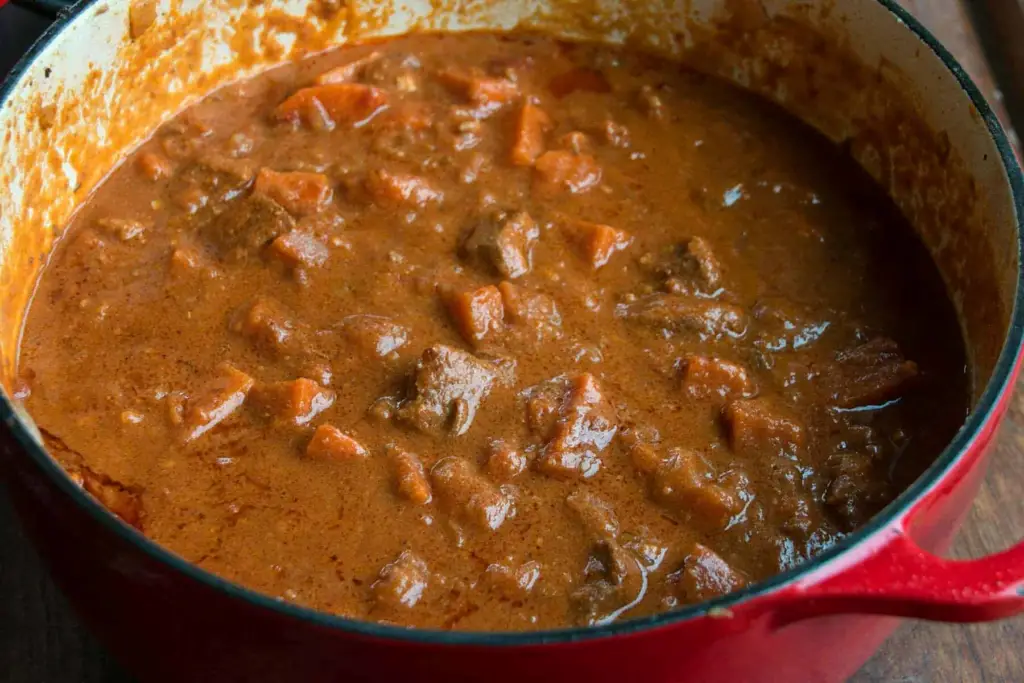
History and Background of Gambian Peanut Stew (Domoda)
Gambian Peanut Stew, locally known as Domoda, is a traditional Mandinka dish and a staple in The Gambia. It is a rich and hearty stew made with concentrated peanut paste, which is a testament to the peanut’s prominence in West African cuisine.
The dish typically includes meat or fish and is seasoned with a variety of ingredients to create a depth of flavor that is both unique and satisfying. The name “Domoda” is derived from the Mandinka words “Domo,” meaning eating, and “Da,” referring to a stew pot, highlighting the dish’s central place in communal dining and Gambian culture.
List of Ingredients for Gambian Peanut Stew (Domoda)
- Meat or fish (as per preference)
- Concentrated peanut paste
- Medium onion, chopped
- Fresh tomatoes, chopped
- Potatoes, cubed
- Carrots, sliced
- Medium cabbage, chopped
- Tomato paste
- Lemon juice
- Soup stock
- White rice
- Salt (to taste)
- Water
Gambian Food Recipes – for Gambian Peanut Stew (Domoda)
Preparation
Clean and cut the meat or fish into desired pieces. Season with salt and other preferred spices.
Cooking the Meat/Fish
In a large pot, add the meat or fish along with chopped onions, tomatoes, and water. Bring to a boil and let it simmer until the meat or fish is partially cooked.
Adding Vegetables
Add the potatoes, carrots, and cabbage to the pot. Continue to simmer until the vegetables are tender.
Peanut Paste
In a separate bowl, mix the concentrated peanut paste with some water to create a smooth consistency. Add this mixture to the pot.
Seasoning
Add tomato paste, lemon juice, and soup stock to the pot. Stir well and let the stew simmer until all the ingredients are well-cooked and the flavors meld together.
Serving:
Once the stew is ready, serve it hot over white rice.
Domoda is a celebration of Gambian flavors, bringing together the nuttiness of peanuts with the richness of meat or fish, complemented by the freshness of vegetables. It’s a dish that truly captures the essence of Gambian cuisine.
Gambian Food Recipes – Jollof Rice

History and Background of Gambian Jollof Rice
Jollof Rice is a beloved dish in many West African countries, each with its own version. In The Gambia, Jollof Rice, also known as “Benachin,” meaning “one pot” in the Wolof language, is a testament to the nation’s love for vibrant and hearty meals.
This dish is a staple at gatherings and a symbol of the country’s rich culinary diversity, blending flavors from various cultural influences, including the Wolof people, who are known for their profound impact on Senegambian cuisine.
List of Ingredients for Gambian Jollof Rice
- 2 cups long-grain rice
- 1 large onion, chopped
- 1 can of chopped tomatoes
- 3 cups chicken or vegetable broth
- 1 teaspoon smoked paprika
- 1 teaspoon cumin
- 1 teaspoon turmeric
- 1 teaspoon garlic powder
- 1 teaspoon ginger powder
- Salt and pepper to taste
- 2 tablespoons vegetable oil
- 3-4 bay leaves
- 1 scotch bonnet pepper (optional)
- Fresh cilantro, chopped for garnish
Gambian Food Recipes – for Gambian Jollof Rice
Rinse the Rice
Begin by rinsing the rice under cold water until the water runs clear. This removes excess starch and prevents the rice from becoming sticky.
Sauté the Onions
Heat the vegetable oil in a large pot over medium heat. Add the chopped onions and sauté until they are soft and translucent.
Tomato Mixture
Stir in the can of chopped tomatoes and cook for a few minutes, allowing the flavors to meld.
Add Broth and Season
Pour in the chicken or vegetable broth and bring the mixture to a boil. Season with smoked paprika, cumin, turmeric, garlic powder, ginger powder, salt, and pepper.
Cook the Rice
Add the rinsed rice to the pot, stirring to ensure it’s well-coated with the tomato mixture. Place the bay leaves and whole scotch bonnet pepper on top.
Simmer
Cover the pot with a tight-fitting lid, reduce the heat to low, and allow the rice to cook for 20-25 minutes, or until it’s tender and the liquid has been absorbed.
Garnish and Serve
Once cooked, remove the bay leaves and scotch bonnet pepper. Fluff the rice with a fork and garnish with freshly chopped cilantro before serving.
Gambian Jollof Rice is a celebration of flavors, with its smoky, spicy, and savory notes. It’s a versatile dish that can be adapted to include vegetables, fish, or meat, making it a hearty meal for any occasion.
Gambian Food Recipes – Chicken Yassa

Chicken Yassa is a tangy and spicy dish that originates from the Senegambia region, particularly popular in Senegal and The Gambia. It is known for its distinctive marination of chicken in a mixture of onions, lemon juice, vinegar, and mustard, which gives it a unique flavor profile.
Here is the history, ingredients list, and a comprehensive recipe for Chicken Yassa:
History and Background
Chicken Yassa, or Yassa au Poulet, has its roots in the Casamance region of Senegal but has become a beloved dish across West Africa, particularly in The Gambia. It reflects the region’s culinary practices of marinating and grilling, influenced by various cultures due to historical trade routes.
Ingredients for Chicken Yassa
- 4-6 boneless, skinless chicken thighs
- 1 large onion, sliced
- 1/4 cup lemon juice
- 3-4 garlic cloves, minced
- 1 teaspoon salt
- 1 teaspoon black pepper
- 1 teaspoon thyme
- 1 teaspoon parsley
- 1 teaspoon red pepper flakes
- 1/2 cup Dijon mustard
- 1/2 cup apple cider vinegar
Gambian Food Recipes – Chicken Yassa
Marination
In a large bowl, combine the chicken thighs with lemon juice, minced garlic, salt, black pepper, thyme, parsley, and red pepper flakes. Let the chicken marinate for at least 1 hour, or overnight for best results.
Onion Mixture
In a separate bowl, mix the sliced onion with Dijon mustard and apple cider vinegar. Allow this mixture to sit and meld flavors for at least 30 minutes.
Cooking Chicken
Heat some oil in a large skillet over medium heat. Add the marinated chicken and cook until browned and cooked through.
Combining
Once the chicken is cooked, add the mustard and onion mixture to the skillet. Let it simmer for a few minutes until the onions are tender and the flavors have combined.
Final Seasoning
Adjust the seasoning with salt and black pepper to taste.
Serving
Serve the chicken hot, accompanied by rice, with the onion-mustard sauce spooned over the top.
Chicken Yassa is a dish that beautifully showcases the fusion of flavors typical in Gambian cuisine, with its use of citrus for acidity, mustard for tanginess, and spices for warmth and depth.
Traditional Gambian food – Superkanja

History and Background of Superkanja: Superkanja is a traditional Gambian dish, and it is known for its use of baobab leaves. Baobab leaves are rich in nutrients and are a common ingredient in West African cuisine. Superkanja is a nutritious and hearty soup that often includes fish or meat, creating a flavorful and wholesome meal.
Traditional Gambian food – Superkanja Ingredients
Note: Ingredient quantities may vary based on personal preferences and the number of servings.
For the Superkanja Soup
- 2 cups baobab leaves (fresh or dried)
- 1 pound fish or meat (tilapia, catfish, or smoked fish are common choices)
- 1 cup groundnuts (peanuts), roasted and ground into a paste
- 2 medium-sized onions, finely chopped
- 2 medium-sized tomatoes, diced
- 2 tablespoons tomato paste
- 2 tablespoons vegetable oil
- 2 cloves garlic, minced
- 1 tablespoon ginger, grated
- 1 teaspoon ground pepper or red pepper flakes (adjust to taste)
- Salt to taste
- 6 cups water or fish stock
For the Optional Rice Balls (Fufu):
- 2 cups rice flour
- Water for mixing
Traditional Gambian food – Superkanja Recipe
Preparing Baobab Leaves
- If using fresh baobab leaves, wash them thoroughly and remove any tough stems. If using dried leaves, soak them in water until they become soft.
- Chop the leaves finely.
Preparing Rice Balls (Fufu) – Optional
- In a bowl, mix rice flour with water to form a smooth, thick paste.
- Boil water in a pot and gradually add the rice flour mixture, stirring continuously until it thickens into a dough-like consistency.
- Shape the mixture into small balls (fufu) and set aside.
Cooking the Superkanja Soup
- In a large pot, heat vegetable oil over medium heat.
- Add chopped onions, minced garlic, and grated ginger. Sauté until the onions are translucent.
- Add diced tomatoes and tomato paste, stirring to combine.
- Add the chopped baobab leaves and groundnut paste to the pot, mixing well.
- Pour in water or fish stock, and bring the mixture to a boil.
- Add the fish or meat of your choice, and simmer until it is ready.
- Season the soup with ground pepper or red pepper flakes and salt to taste.
- Allow the Superkanja to simmer for about 20-30 minutes, allowing the flavors to meld.
Serving
- Serve Superkanja hot over a bed of rice balls (fufu) if desired.
- Garnish with additional chopped onions and tomatoes if desired.
Enjoy your Gambian Superkanja!
Superkanja is a nutritious and flavorful dish that showcases the richness of Gambian cuisine. The combination of baobab leaves, groundnuts, and various spices creates a unique and satisfying culinary experience. Adjust the spice levels and ingredients to suit your taste preferences.
Gambian Food Recipes – Benachin

Benachin is a traditional Gambian dish that chefs typically cook in a single pot, which gives it its name. The dish is a flavorful combination of various ingredients, including fish or meat, seasoned with an array of herbs and spices. Benachin is a staple in many Gambian households and is a testament to the country’s rich culinary traditions.
Gambian Cuisine – Benachin Ingredients
- Fish or meat (as per preference)
- Rice
- Onions (chopped)
- Tomatoes (chopped)
- Lemon juice
- Basil
- Aubergine
- Parsley
- Onion
- Chili
- Tomato
- Pumpkin
- Carrot
- Cabbage
- Vegetable oil
- Water
- Tomato paste (sometimes added for color)
Gambian Cuisine – Benachin Recipe
- Preparation: Begin by cleaning and cutting the fish or meat into desired pieces. Season with salt, pepper, and other preferred spices.
- Cooking: In a large pot, heat the vegetable oil. Add the chopped onions and sauté until they become translucent.
- Adding Vegetables: Add the chopped tomatoes, aubergine, pumpkin, carrot, and cabbage to the pot. Stir well and let it cook for a few minutes.
- Fish or Meat: Add the fish or meat pieces to the pot. Mix well, ensuring that the spices and herbs cpat the ingredients.
- Simmering: Add water to the pot and bring the mixture to a boil. Once boiling, reduce the heat and let it simmer until the fish or meat is ready and the vegetables are tender.
- Rice: Add the rice to the pot. Cover the pot and let it cook until the rice is ready.
- Final Touches: Adjust the seasoning if necessary. Once cooked, garnish the Benachin with chopped parsley and serve hot.
Benachin is a hearty and flavorful dish that captures the essence of Gambian cuisine. It’s a must-try for anyone looking to explore the culinary delights of West Africa.
Gambian Recipes – Domoda

Domoda is a traditional Mandinka dish from The Gambia. It is a flavorful stew they make with concentrated peanut paste. The dish typically includes meat or fish, seasoned with various ingredients to create a rich and hearty meal.
The name “Domoda” comes from the root word from “Domo,” which means eating, and “Da,” which refers to a stew pot.
Gambian Recipes – Domoda Ingredients
- Meat or fish (as per preference)
- Concentrated peanut paste
- Medium onion (chopped)
- Fresh tomatoes (chopped)
- Potatoes (cubed)
- Carrots (sliced)
- Medium cabbage (chopped)
- Tomato paste
- Lemon juice
- Soup stock
- White rice
- Salt (to taste)
- Water
Gambian Recipes – Domoda Recipe
- Preparation: Begin by cleaning and cutting the meat or fish into desired pieces. Season with salt and other preferred spices.
- Cooking the Meat/Fish: In a large pot, add the meat or fish along with chopped onions, tomatoes, and water. Bring to a boil and let it simmer until the meat or fish is partially cooked.
- Adding Vegetables: Add the potatoes, carrots, and cabbage to the pot. Continue to simmer until the vegetables are tender.
- Peanut Paste: In a separate bowl, mix the concentrated peanut paste with some water to create a smooth consistency. Add this mixture to the pot.
- Seasoning: Add tomato paste, lemon juice, and soup stock to the pot. Stir well and let the stew simmer until all the ingredients are well-cooked and the flavors meld together.
- Serving: Once the stew is ready, serve it hot over white rice.
Domoda is a rich and hearty dish that captures the essence of Gambian cuisine. The combination of peanut paste with meat or fish offers a unique taste experience that is both satisfying and flavorful.
Conclusion: Celebrating the Delights of Gambian Cuisine
As I journeyed through the heart of Gambian culinary traditions, I discovered a treasure trove of flavors and tastes that left me in awe. From the aromatic spices to the staple food items that chefs commonly use in Gambian cooking, the authentic ingredients in Gambian cuisine are what give it its unique flavors.
The traditional cooking techniques employed in Gambian cuisine, from slow-cooking methods to the use of specific utensils, contribute to the authentic flavors of Gambian dishes. And the beloved Gambian recipes, ranging from hearty stews to spicy snacks, are perfect for any occasion.
Embarking on a culinary adventure in The Gambia allowed me to immerse myself in the vibrant flavors of Gambian cuisine and appreciate its cultural significance in West Africa. It was fascinating to see how Gambian cuisine has evolved over time, from the traditional recipes passed down through generations to the modern adaptations influenced by globalization.
Through a popular Gambian food blog, I learned how to recreate these delicious dishes in my own kitchen, and I invite you to do the same. Celebrate the delights of Gambian cuisine by trying out some of these recipes and experiencing the unique tastes that make it a gem of African culinary traditions.
FAQ’s
What are some traditional Gambian Recipes?
Some traditional Gambian dishes include domoda (peanut stew), benechin (one-pot rice dish), and yassa (marinated grilled meat or fish).
What are some authentic Gambian ingredients?
Authentic Gambian ingredients include groundnut (peanut) oil, yams, cassava, and spices like ginger, garlic, and chili peppers.
What are some Gambian cooking techniques?
Gambian cooking techniques often involve slow-cooking methods, such as simmering stews for hours to develop rich flavors. Chefs use specific utensils like a mortar and pestle.
Can you share some popular Gambian Recipes?
Sure! Some popular Gambian recipes include domoda (peanut stew with meat), benachin (one-pot rice with vegetables and meat), and akara (fried black-eyed pea fritters).
What can I expect from a culinary adventure in The Gambia?
A culinary adventure in The Gambia offers a chance to explore the vibrant flavors of Gambian cuisine, from trying street food delights to indulging in traditional dishes at local restaurants.
What is the Gambia National Dish?
The Gambia’s national dish is domoda, a flavorful peanut stew. It is made with meat (usually chicken or beef), vegetables such as okra and sweet potatoes, and a rich peanut butter sauce. The dish is typically served with rice and enjoyed by locals and visitors alike.
Where can I find Gambian recipes and cooking tips?
You can find a wealth of Gambian recipes and cooking tips on popular Gambian food blogs, which provide step-by-step instructions and insights into the country’s culinary traditions.
What is Mbahal Gambian Food?
Mbahal Gambian food is a traditional cuisine from Gambia, known for its rich flavors and unique cooking techniques. It typically consists of fish, meat, or vegetables marinated in a spicy sauce made with ground peanuts, tomato, and various spices.
The dish is then wrapped in banana leaves and cooked slowly over hot coals, giving it a smoky and delicious taste.
Why is Gambian cuisine significant in West Africa?
Gambian cuisine holds cultural significance in West Africa due to its unique blend of flavors and traditional cooking techniques, which have influenced the culinary traditions of the region.
How has Gambian cuisine evolved over time?
Gambian cuisine has evolved from traditional recipes passed down through generations to modern adaptations influenced by globalization, resulting in a fusion of traditional and contemporary flavors.
What makes Gambian cuisine special?
Gambian cuisine is special because it embodies the rich cultural heritage of The Gambia, showcasing unique flavors, ingredients, and cooking techniques that are treasured by locals and food enthusiasts alike.
Last Edited

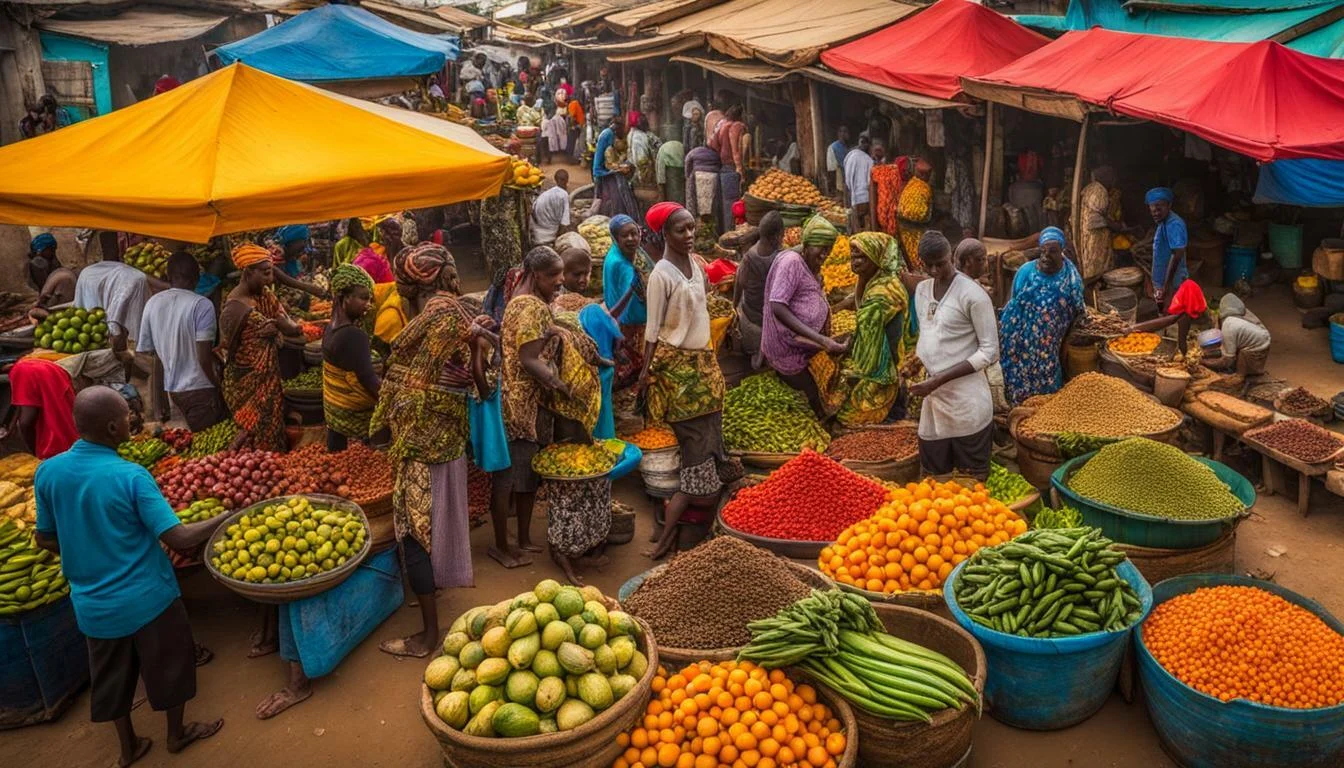
Your articles are extremely helpful to me. May I ask for more information?